Financial Accounting Principle
VerifiedAdded on 2020/12/24
|36
|9395
|326
Project
AI Summary
This project provides a comprehensive guide to financial accounting principles, covering topics such as double-entry bookkeeping, trial balance preparation, financial statement analysis, and bank reconciliation. It explores the importance of accounting concepts, conventions, and regulations in ensuring accurate and reliable financial reporting.
Contribute Materials
Your contribution can guide someone’s learning journey. Share your
documents today.
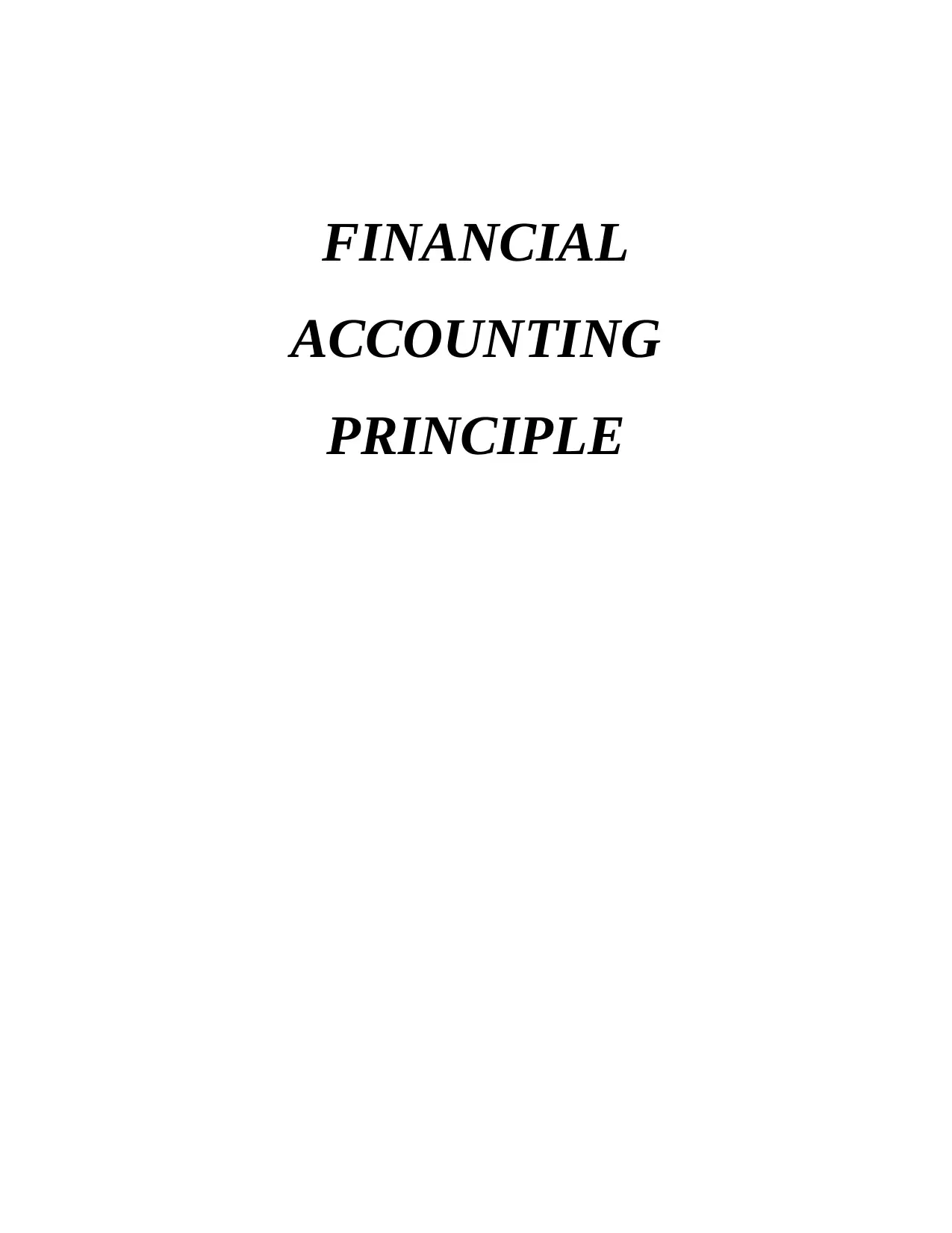
FINANCIAL
ACCOUNTING
PRINCIPLE
ACCOUNTING
PRINCIPLE
Secure Best Marks with AI Grader
Need help grading? Try our AI Grader for instant feedback on your assignments.
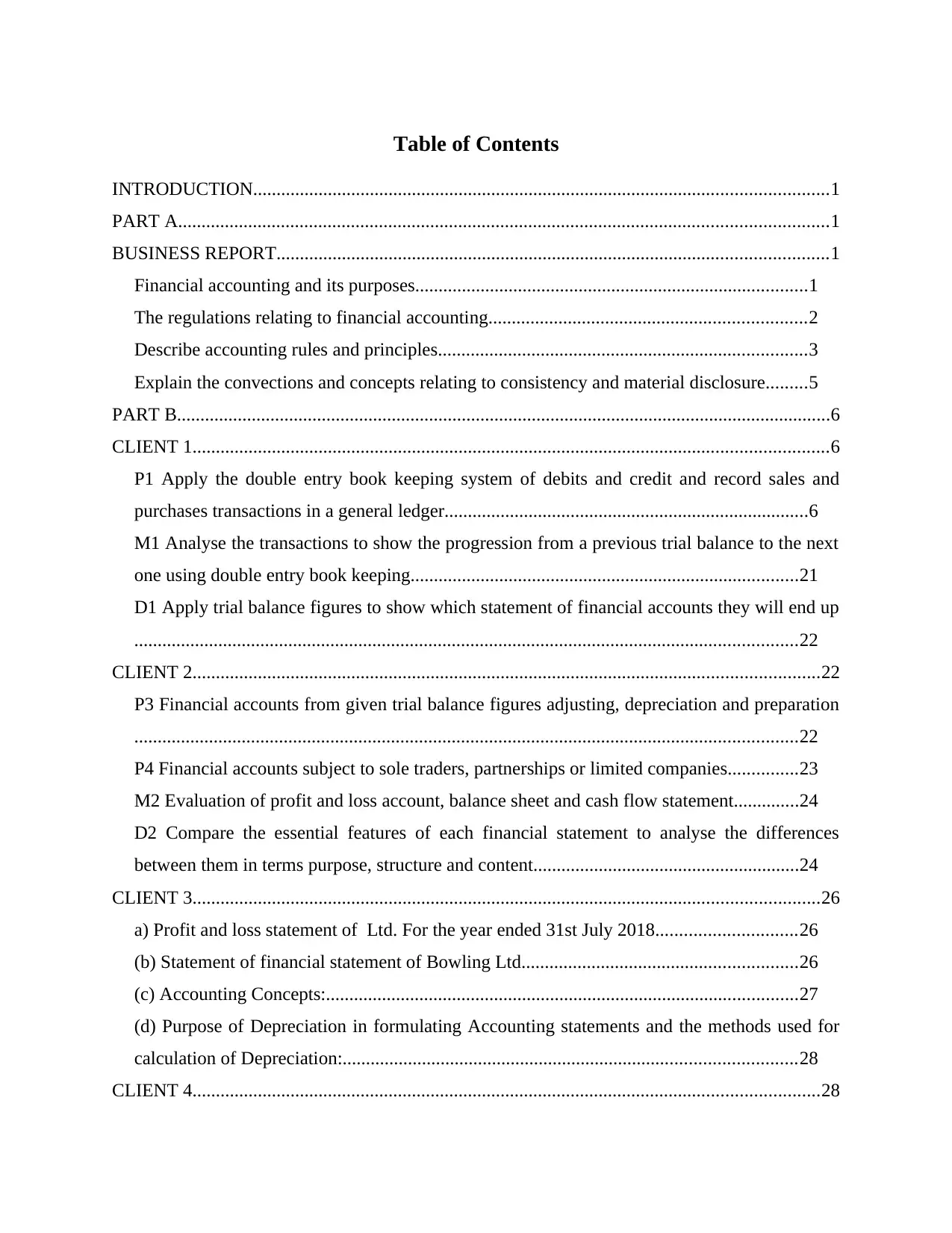
Table of Contents
INTRODUCTION...........................................................................................................................1
PART A...........................................................................................................................................1
BUSINESS REPORT......................................................................................................................1
Financial accounting and its purposes....................................................................................1
The regulations relating to financial accounting....................................................................2
Describe accounting rules and principles...............................................................................3
Explain the convections and concepts relating to consistency and material disclosure.........5
PART B............................................................................................................................................6
CLIENT 1........................................................................................................................................6
P1 Apply the double entry book keeping system of debits and credit and record sales and
purchases transactions in a general ledger..............................................................................6
M1 Analyse the transactions to show the progression from a previous trial balance to the next
one using double entry book keeping...................................................................................21
D1 Apply trial balance figures to show which statement of financial accounts they will end up
..............................................................................................................................................22
CLIENT 2......................................................................................................................................22
P3 Financial accounts from given trial balance figures adjusting, depreciation and preparation
..............................................................................................................................................22
P4 Financial accounts subject to sole traders, partnerships or limited companies...............23
M2 Evaluation of profit and loss account, balance sheet and cash flow statement..............24
D2 Compare the essential features of each financial statement to analyse the differences
between them in terms purpose, structure and content.........................................................24
CLIENT 3......................................................................................................................................26
a) Profit and loss statement of Ltd. For the year ended 31st July 2018..............................26
(b) Statement of financial statement of Bowling Ltd...........................................................26
(c) Accounting Concepts:.....................................................................................................27
(d) Purpose of Depreciation in formulating Accounting statements and the methods used for
calculation of Depreciation:.................................................................................................28
CLIENT 4......................................................................................................................................28
INTRODUCTION...........................................................................................................................1
PART A...........................................................................................................................................1
BUSINESS REPORT......................................................................................................................1
Financial accounting and its purposes....................................................................................1
The regulations relating to financial accounting....................................................................2
Describe accounting rules and principles...............................................................................3
Explain the convections and concepts relating to consistency and material disclosure.........5
PART B............................................................................................................................................6
CLIENT 1........................................................................................................................................6
P1 Apply the double entry book keeping system of debits and credit and record sales and
purchases transactions in a general ledger..............................................................................6
M1 Analyse the transactions to show the progression from a previous trial balance to the next
one using double entry book keeping...................................................................................21
D1 Apply trial balance figures to show which statement of financial accounts they will end up
..............................................................................................................................................22
CLIENT 2......................................................................................................................................22
P3 Financial accounts from given trial balance figures adjusting, depreciation and preparation
..............................................................................................................................................22
P4 Financial accounts subject to sole traders, partnerships or limited companies...............23
M2 Evaluation of profit and loss account, balance sheet and cash flow statement..............24
D2 Compare the essential features of each financial statement to analyse the differences
between them in terms purpose, structure and content.........................................................24
CLIENT 3......................................................................................................................................26
a) Profit and loss statement of Ltd. For the year ended 31st July 2018..............................26
(b) Statement of financial statement of Bowling Ltd...........................................................26
(c) Accounting Concepts:.....................................................................................................27
(d) Purpose of Depreciation in formulating Accounting statements and the methods used for
calculation of Depreciation:.................................................................................................28
CLIENT 4......................................................................................................................................28
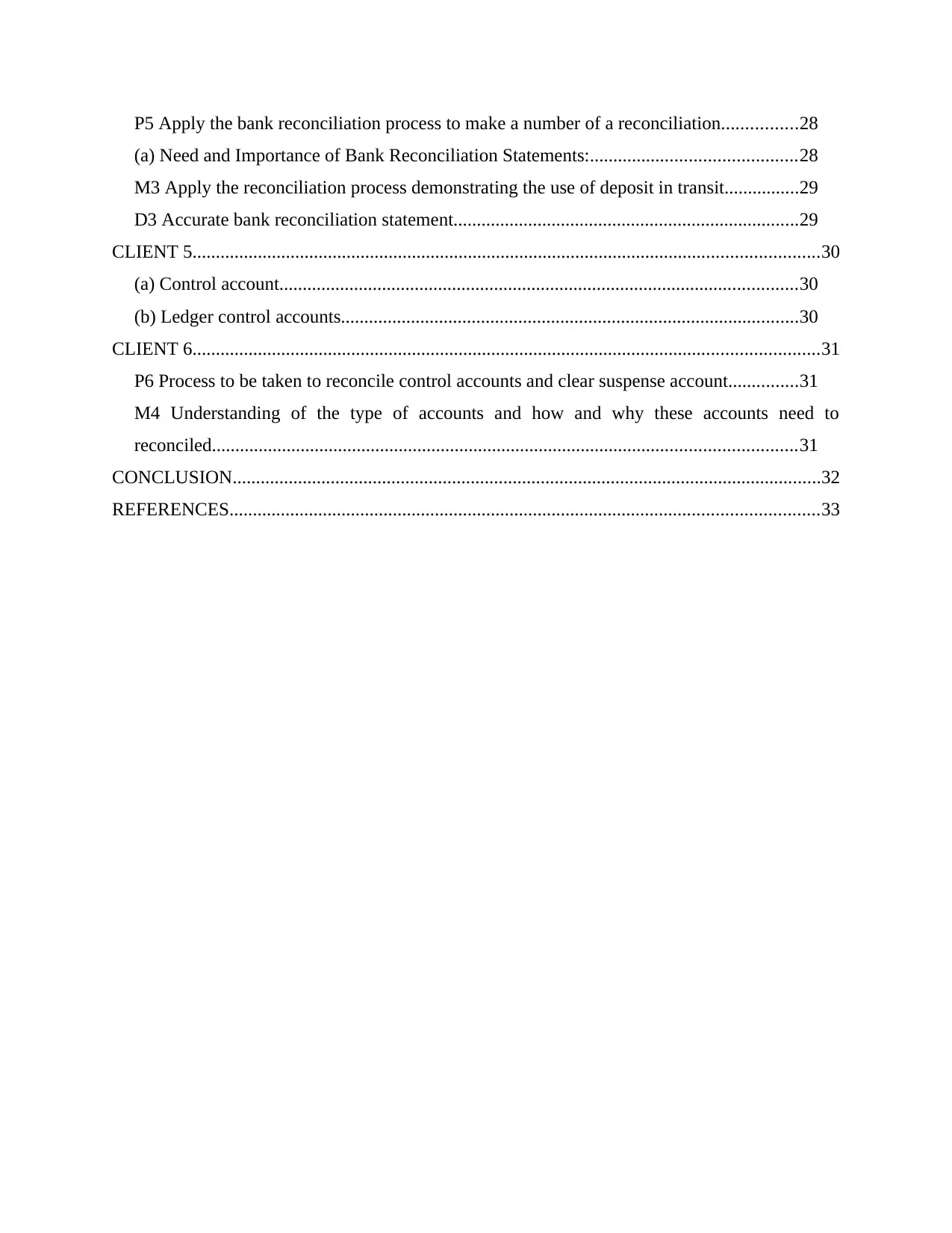
P5 Apply the bank reconciliation process to make a number of a reconciliation................28
(a) Need and Importance of Bank Reconciliation Statements:............................................28
M3 Apply the reconciliation process demonstrating the use of deposit in transit................29
D3 Accurate bank reconciliation statement..........................................................................29
CLIENT 5......................................................................................................................................30
(a) Control account...............................................................................................................30
(b) Ledger control accounts..................................................................................................30
CLIENT 6......................................................................................................................................31
P6 Process to be taken to reconcile control accounts and clear suspense account...............31
M4 Understanding of the type of accounts and how and why these accounts need to
reconciled.............................................................................................................................31
CONCLUSION..............................................................................................................................32
REFERENCES..............................................................................................................................33
(a) Need and Importance of Bank Reconciliation Statements:............................................28
M3 Apply the reconciliation process demonstrating the use of deposit in transit................29
D3 Accurate bank reconciliation statement..........................................................................29
CLIENT 5......................................................................................................................................30
(a) Control account...............................................................................................................30
(b) Ledger control accounts..................................................................................................30
CLIENT 6......................................................................................................................................31
P6 Process to be taken to reconcile control accounts and clear suspense account...............31
M4 Understanding of the type of accounts and how and why these accounts need to
reconciled.............................................................................................................................31
CONCLUSION..............................................................................................................................32
REFERENCES..............................................................................................................................33
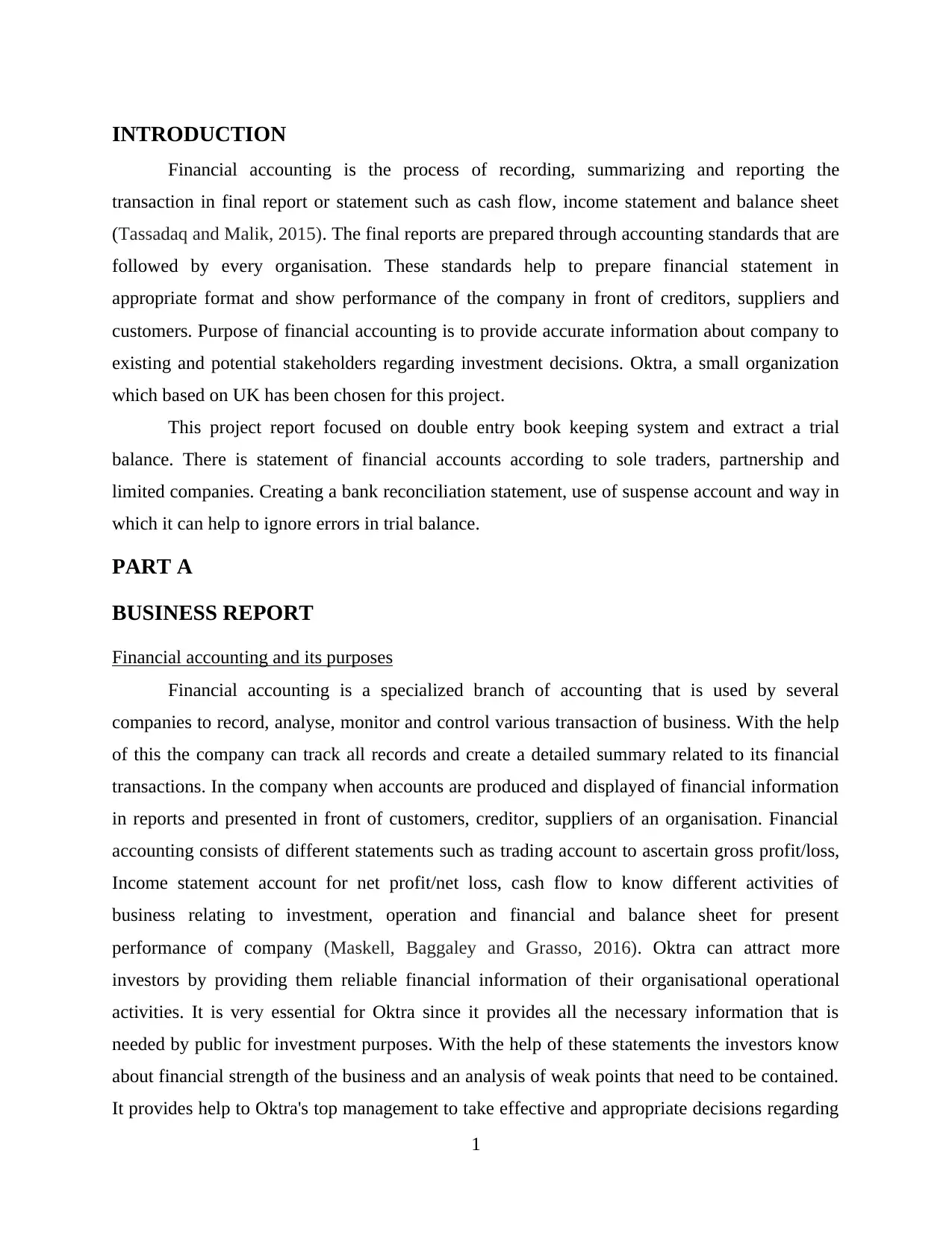
INTRODUCTION
Financial accounting is the process of recording, summarizing and reporting the
transaction in final report or statement such as cash flow, income statement and balance sheet
(Tassadaq and Malik, 2015). The final reports are prepared through accounting standards that are
followed by every organisation. These standards help to prepare financial statement in
appropriate format and show performance of the company in front of creditors, suppliers and
customers. Purpose of financial accounting is to provide accurate information about company to
existing and potential stakeholders regarding investment decisions. Oktra, a small organization
which based on UK has been chosen for this project.
This project report focused on double entry book keeping system and extract a trial
balance. There is statement of financial accounts according to sole traders, partnership and
limited companies. Creating a bank reconciliation statement, use of suspense account and way in
which it can help to ignore errors in trial balance.
PART A
BUSINESS REPORT
Financial accounting and its purposes
Financial accounting is a specialized branch of accounting that is used by several
companies to record, analyse, monitor and control various transaction of business. With the help
of this the company can track all records and create a detailed summary related to its financial
transactions. In the company when accounts are produced and displayed of financial information
in reports and presented in front of customers, creditor, suppliers of an organisation. Financial
accounting consists of different statements such as trading account to ascertain gross profit/loss,
Income statement account for net profit/net loss, cash flow to know different activities of
business relating to investment, operation and financial and balance sheet for present
performance of company (Maskell, Baggaley and Grasso, 2016). Oktra can attract more
investors by providing them reliable financial information of their organisational operational
activities. It is very essential for Oktra since it provides all the necessary information that is
needed by public for investment purposes. With the help of these statements the investors know
about financial strength of the business and an analysis of weak points that need to be contained.
It provides help to Oktra's top management to take effective and appropriate decisions regarding
1
Financial accounting is the process of recording, summarizing and reporting the
transaction in final report or statement such as cash flow, income statement and balance sheet
(Tassadaq and Malik, 2015). The final reports are prepared through accounting standards that are
followed by every organisation. These standards help to prepare financial statement in
appropriate format and show performance of the company in front of creditors, suppliers and
customers. Purpose of financial accounting is to provide accurate information about company to
existing and potential stakeholders regarding investment decisions. Oktra, a small organization
which based on UK has been chosen for this project.
This project report focused on double entry book keeping system and extract a trial
balance. There is statement of financial accounts according to sole traders, partnership and
limited companies. Creating a bank reconciliation statement, use of suspense account and way in
which it can help to ignore errors in trial balance.
PART A
BUSINESS REPORT
Financial accounting and its purposes
Financial accounting is a specialized branch of accounting that is used by several
companies to record, analyse, monitor and control various transaction of business. With the help
of this the company can track all records and create a detailed summary related to its financial
transactions. In the company when accounts are produced and displayed of financial information
in reports and presented in front of customers, creditor, suppliers of an organisation. Financial
accounting consists of different statements such as trading account to ascertain gross profit/loss,
Income statement account for net profit/net loss, cash flow to know different activities of
business relating to investment, operation and financial and balance sheet for present
performance of company (Maskell, Baggaley and Grasso, 2016). Oktra can attract more
investors by providing them reliable financial information of their organisational operational
activities. It is very essential for Oktra since it provides all the necessary information that is
needed by public for investment purposes. With the help of these statements the investors know
about financial strength of the business and an analysis of weak points that need to be contained.
It provides help to Oktra's top management to take effective and appropriate decisions regarding
1
Secure Best Marks with AI Grader
Need help grading? Try our AI Grader for instant feedback on your assignments.
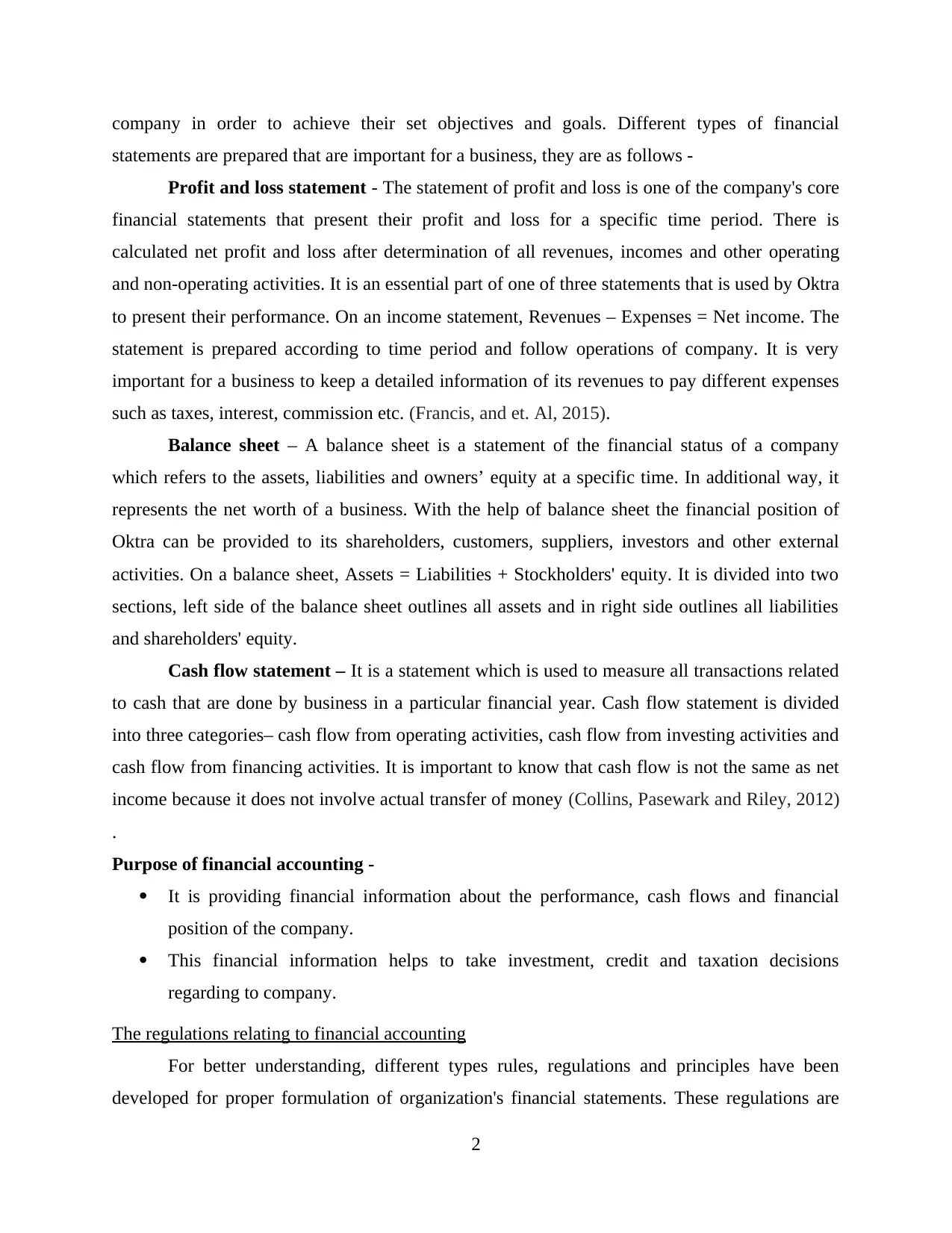
company in order to achieve their set objectives and goals. Different types of financial
statements are prepared that are important for a business, they are as follows -
Profit and loss statement - The statement of profit and loss is one of the company's core
financial statements that present their profit and loss for a specific time period. There is
calculated net profit and loss after determination of all revenues, incomes and other operating
and non-operating activities. It is an essential part of one of three statements that is used by Oktra
to present their performance. On an income statement, Revenues – Expenses = Net income. The
statement is prepared according to time period and follow operations of company. It is very
important for a business to keep a detailed information of its revenues to pay different expenses
such as taxes, interest, commission etc. (Francis, and et. Al, 2015).
Balance sheet – A balance sheet is a statement of the financial status of a company
which refers to the assets, liabilities and owners’ equity at a specific time. In additional way, it
represents the net worth of a business. With the help of balance sheet the financial position of
Oktra can be provided to its shareholders, customers, suppliers, investors and other external
activities. On a balance sheet, Assets = Liabilities + Stockholders' equity. It is divided into two
sections, left side of the balance sheet outlines all assets and in right side outlines all liabilities
and shareholders' equity.
Cash flow statement – It is a statement which is used to measure all transactions related
to cash that are done by business in a particular financial year. Cash flow statement is divided
into three categories– cash flow from operating activities, cash flow from investing activities and
cash flow from financing activities. It is important to know that cash flow is not the same as net
income because it does not involve actual transfer of money (Collins, Pasewark and Riley, 2012)
.
Purpose of financial accounting -
It is providing financial information about the performance, cash flows and financial
position of the company.
This financial information helps to take investment, credit and taxation decisions
regarding to company.
The regulations relating to financial accounting
For better understanding, different types rules, regulations and principles have been
developed for proper formulation of organization's financial statements. These regulations are
2
statements are prepared that are important for a business, they are as follows -
Profit and loss statement - The statement of profit and loss is one of the company's core
financial statements that present their profit and loss for a specific time period. There is
calculated net profit and loss after determination of all revenues, incomes and other operating
and non-operating activities. It is an essential part of one of three statements that is used by Oktra
to present their performance. On an income statement, Revenues – Expenses = Net income. The
statement is prepared according to time period and follow operations of company. It is very
important for a business to keep a detailed information of its revenues to pay different expenses
such as taxes, interest, commission etc. (Francis, and et. Al, 2015).
Balance sheet – A balance sheet is a statement of the financial status of a company
which refers to the assets, liabilities and owners’ equity at a specific time. In additional way, it
represents the net worth of a business. With the help of balance sheet the financial position of
Oktra can be provided to its shareholders, customers, suppliers, investors and other external
activities. On a balance sheet, Assets = Liabilities + Stockholders' equity. It is divided into two
sections, left side of the balance sheet outlines all assets and in right side outlines all liabilities
and shareholders' equity.
Cash flow statement – It is a statement which is used to measure all transactions related
to cash that are done by business in a particular financial year. Cash flow statement is divided
into three categories– cash flow from operating activities, cash flow from investing activities and
cash flow from financing activities. It is important to know that cash flow is not the same as net
income because it does not involve actual transfer of money (Collins, Pasewark and Riley, 2012)
.
Purpose of financial accounting -
It is providing financial information about the performance, cash flows and financial
position of the company.
This financial information helps to take investment, credit and taxation decisions
regarding to company.
The regulations relating to financial accounting
For better understanding, different types rules, regulations and principles have been
developed for proper formulation of organization's financial statements. These regulations are
2

help to maintain their financial account in an accurate way. All companies including Oktra
follow particular rules and regulations of financial accounting applicable to it. These regulations
provide guidance to investor for analysis of income statements, balance sheet and cash flow
statement. These regulations are introduced by regulatory authority of a country for recording
information in financial statement in appropriate way (Watrin, Pott and Ullmann, 2012). It is
possible to get reliable information from various statement. There are following reliable
regulations -
IFRS – International financial reporting standard was introduced a set of world wide
language. The businesses are using standards for their accounts and mangers apply them to
expand their business globally. There is continuous application of different accounting standards
according to different transactions.
IASB – International accounting standard board is a regularity authority who is liable to
introduce and develop several international financial accounting standards. It has been
introduced by IFRS that are formulated to guide organisations while preparing financial
accounts. At time when organisations are recording transactions in books they follow their rules
and regulations.
IFRS 9 – It is applied in financial accounting instruments for different financial
statements. With the help of this regulation the company can easily measure and identify their
financial assets.
IFRS 10 – It provides a guideline to combined businesses who formulate their financial
statements in consolidated form. It is mainly developed for parent entity which is responsible for
their subsidiaries.
Describe accounting rules and principles
Accounting principles are a set of rules and guidelines followed by companies while
preparing a financial report. The principles of accounting define particular criteria under which
all companies have to maintain their economic transactions in accounting books. There are
following accounting principles -
Business entity concept –
The business entity concept defines that entity of a business are presented as separate
legal entity distinct from its members (Lobo and Zhao, 2013). It means Oktra has a personal
identification on the basis of which it can carry out transactions in its own name, sue or be sued
3
follow particular rules and regulations of financial accounting applicable to it. These regulations
provide guidance to investor for analysis of income statements, balance sheet and cash flow
statement. These regulations are introduced by regulatory authority of a country for recording
information in financial statement in appropriate way (Watrin, Pott and Ullmann, 2012). It is
possible to get reliable information from various statement. There are following reliable
regulations -
IFRS – International financial reporting standard was introduced a set of world wide
language. The businesses are using standards for their accounts and mangers apply them to
expand their business globally. There is continuous application of different accounting standards
according to different transactions.
IASB – International accounting standard board is a regularity authority who is liable to
introduce and develop several international financial accounting standards. It has been
introduced by IFRS that are formulated to guide organisations while preparing financial
accounts. At time when organisations are recording transactions in books they follow their rules
and regulations.
IFRS 9 – It is applied in financial accounting instruments for different financial
statements. With the help of this regulation the company can easily measure and identify their
financial assets.
IFRS 10 – It provides a guideline to combined businesses who formulate their financial
statements in consolidated form. It is mainly developed for parent entity which is responsible for
their subsidiaries.
Describe accounting rules and principles
Accounting principles are a set of rules and guidelines followed by companies while
preparing a financial report. The principles of accounting define particular criteria under which
all companies have to maintain their economic transactions in accounting books. There are
following accounting principles -
Business entity concept –
The business entity concept defines that entity of a business are presented as separate
legal entity distinct from its members (Lobo and Zhao, 2013). It means Oktra has a personal
identification on the basis of which it can carry out transactions in its own name, sue or be sued
3
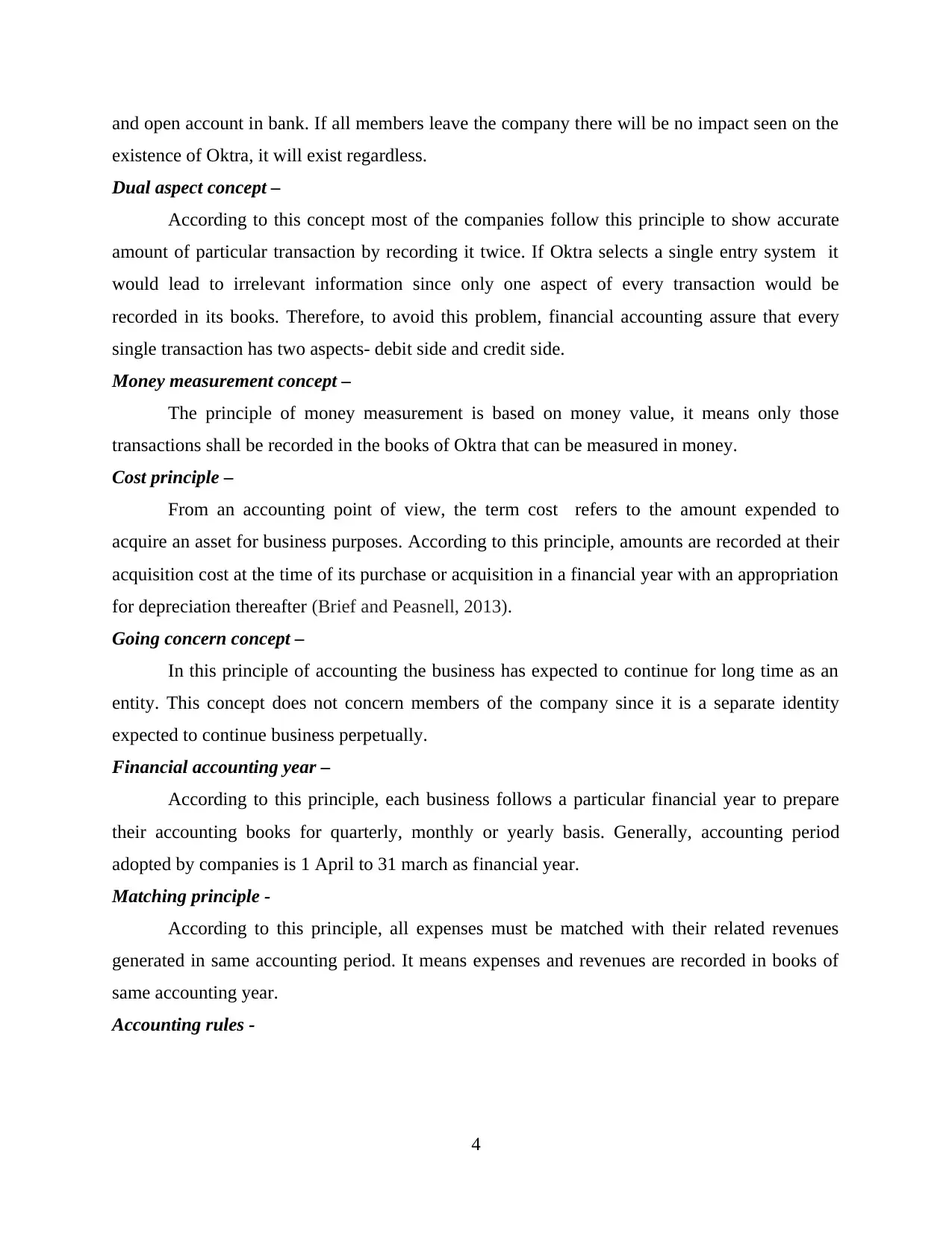
and open account in bank. If all members leave the company there will be no impact seen on the
existence of Oktra, it will exist regardless.
Dual aspect concept –
According to this concept most of the companies follow this principle to show accurate
amount of particular transaction by recording it twice. If Oktra selects a single entry system it
would lead to irrelevant information since only one aspect of every transaction would be
recorded in its books. Therefore, to avoid this problem, financial accounting assure that every
single transaction has two aspects- debit side and credit side.
Money measurement concept –
The principle of money measurement is based on money value, it means only those
transactions shall be recorded in the books of Oktra that can be measured in money.
Cost principle –
From an accounting point of view, the term cost refers to the amount expended to
acquire an asset for business purposes. According to this principle, amounts are recorded at their
acquisition cost at the time of its purchase or acquisition in a financial year with an appropriation
for depreciation thereafter (Brief and Peasnell, 2013).
Going concern concept –
In this principle of accounting the business has expected to continue for long time as an
entity. This concept does not concern members of the company since it is a separate identity
expected to continue business perpetually.
Financial accounting year –
According to this principle, each business follows a particular financial year to prepare
their accounting books for quarterly, monthly or yearly basis. Generally, accounting period
adopted by companies is 1 April to 31 march as financial year.
Matching principle -
According to this principle, all expenses must be matched with their related revenues
generated in same accounting period. It means expenses and revenues are recorded in books of
same accounting year.
Accounting rules -
4
existence of Oktra, it will exist regardless.
Dual aspect concept –
According to this concept most of the companies follow this principle to show accurate
amount of particular transaction by recording it twice. If Oktra selects a single entry system it
would lead to irrelevant information since only one aspect of every transaction would be
recorded in its books. Therefore, to avoid this problem, financial accounting assure that every
single transaction has two aspects- debit side and credit side.
Money measurement concept –
The principle of money measurement is based on money value, it means only those
transactions shall be recorded in the books of Oktra that can be measured in money.
Cost principle –
From an accounting point of view, the term cost refers to the amount expended to
acquire an asset for business purposes. According to this principle, amounts are recorded at their
acquisition cost at the time of its purchase or acquisition in a financial year with an appropriation
for depreciation thereafter (Brief and Peasnell, 2013).
Going concern concept –
In this principle of accounting the business has expected to continue for long time as an
entity. This concept does not concern members of the company since it is a separate identity
expected to continue business perpetually.
Financial accounting year –
According to this principle, each business follows a particular financial year to prepare
their accounting books for quarterly, monthly or yearly basis. Generally, accounting period
adopted by companies is 1 April to 31 march as financial year.
Matching principle -
According to this principle, all expenses must be matched with their related revenues
generated in same accounting period. It means expenses and revenues are recorded in books of
same accounting year.
Accounting rules -
4
Paraphrase This Document
Need a fresh take? Get an instant paraphrase of this document with our AI Paraphraser
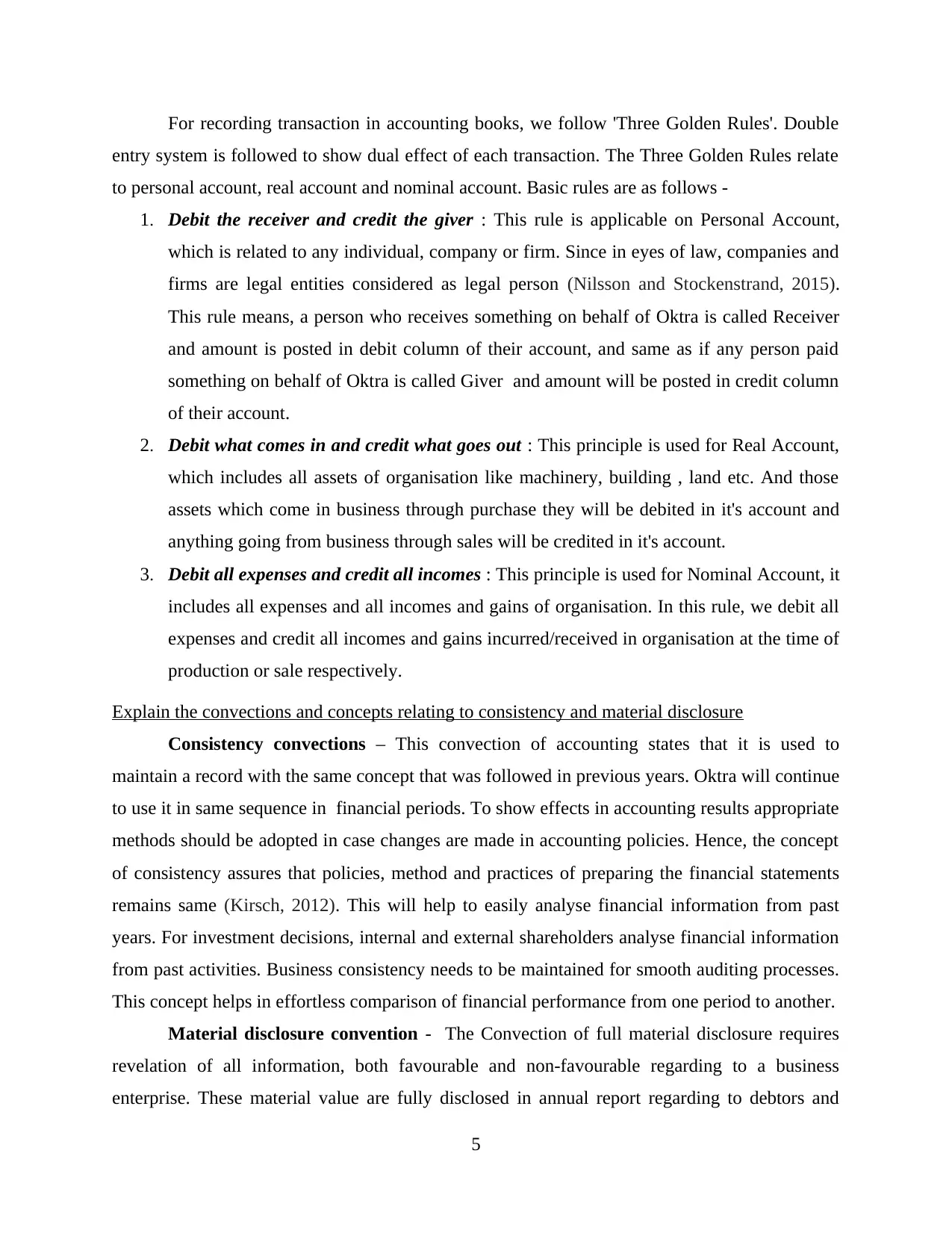
For recording transaction in accounting books, we follow 'Three Golden Rules'. Double
entry system is followed to show dual effect of each transaction. The Three Golden Rules relate
to personal account, real account and nominal account. Basic rules are as follows -
1. Debit the receiver and credit the giver : This rule is applicable on Personal Account,
which is related to any individual, company or firm. Since in eyes of law, companies and
firms are legal entities considered as legal person (Nilsson and Stockenstrand, 2015).
This rule means, a person who receives something on behalf of Oktra is called Receiver
and amount is posted in debit column of their account, and same as if any person paid
something on behalf of Oktra is called Giver and amount will be posted in credit column
of their account.
2. Debit what comes in and credit what goes out : This principle is used for Real Account,
which includes all assets of organisation like machinery, building , land etc. And those
assets which come in business through purchase they will be debited in it's account and
anything going from business through sales will be credited in it's account.
3. Debit all expenses and credit all incomes : This principle is used for Nominal Account, it
includes all expenses and all incomes and gains of organisation. In this rule, we debit all
expenses and credit all incomes and gains incurred/received in organisation at the time of
production or sale respectively.
Explain the convections and concepts relating to consistency and material disclosure
Consistency convections – This convection of accounting states that it is used to
maintain a record with the same concept that was followed in previous years. Oktra will continue
to use it in same sequence in financial periods. To show effects in accounting results appropriate
methods should be adopted in case changes are made in accounting policies. Hence, the concept
of consistency assures that policies, method and practices of preparing the financial statements
remains same (Kirsch, 2012). This will help to easily analyse financial information from past
years. For investment decisions, internal and external shareholders analyse financial information
from past activities. Business consistency needs to be maintained for smooth auditing processes.
This concept helps in effortless comparison of financial performance from one period to another.
Material disclosure convention - The Convection of full material disclosure requires
revelation of all information, both favourable and non-favourable regarding to a business
enterprise. These material value are fully disclosed in annual report regarding to debtors and
5
entry system is followed to show dual effect of each transaction. The Three Golden Rules relate
to personal account, real account and nominal account. Basic rules are as follows -
1. Debit the receiver and credit the giver : This rule is applicable on Personal Account,
which is related to any individual, company or firm. Since in eyes of law, companies and
firms are legal entities considered as legal person (Nilsson and Stockenstrand, 2015).
This rule means, a person who receives something on behalf of Oktra is called Receiver
and amount is posted in debit column of their account, and same as if any person paid
something on behalf of Oktra is called Giver and amount will be posted in credit column
of their account.
2. Debit what comes in and credit what goes out : This principle is used for Real Account,
which includes all assets of organisation like machinery, building , land etc. And those
assets which come in business through purchase they will be debited in it's account and
anything going from business through sales will be credited in it's account.
3. Debit all expenses and credit all incomes : This principle is used for Nominal Account, it
includes all expenses and all incomes and gains of organisation. In this rule, we debit all
expenses and credit all incomes and gains incurred/received in organisation at the time of
production or sale respectively.
Explain the convections and concepts relating to consistency and material disclosure
Consistency convections – This convection of accounting states that it is used to
maintain a record with the same concept that was followed in previous years. Oktra will continue
to use it in same sequence in financial periods. To show effects in accounting results appropriate
methods should be adopted in case changes are made in accounting policies. Hence, the concept
of consistency assures that policies, method and practices of preparing the financial statements
remains same (Kirsch, 2012). This will help to easily analyse financial information from past
years. For investment decisions, internal and external shareholders analyse financial information
from past activities. Business consistency needs to be maintained for smooth auditing processes.
This concept helps in effortless comparison of financial performance from one period to another.
Material disclosure convention - The Convection of full material disclosure requires
revelation of all information, both favourable and non-favourable regarding to a business
enterprise. These material value are fully disclosed in annual report regarding to debtors and
5
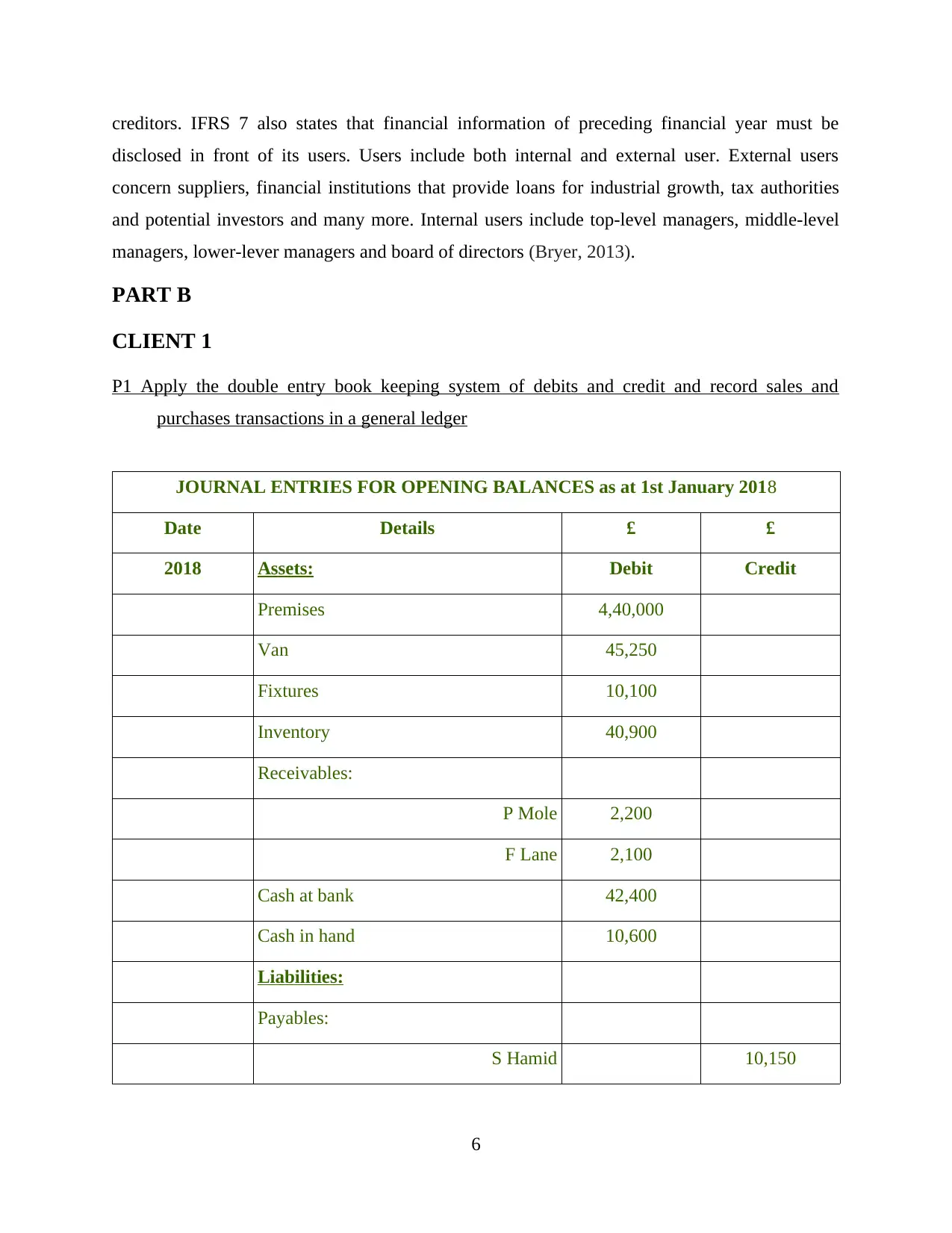
creditors. IFRS 7 also states that financial information of preceding financial year must be
disclosed in front of its users. Users include both internal and external user. External users
concern suppliers, financial institutions that provide loans for industrial growth, tax authorities
and potential investors and many more. Internal users include top-level managers, middle-level
managers, lower-lever managers and board of directors (Bryer, 2013).
PART B
CLIENT 1
P1 Apply the double entry book keeping system of debits and credit and record sales and
purchases transactions in a general ledger
JOURNAL ENTRIES FOR OPENING BALANCES as at 1st January 2018
Date Details £ £
2018 Assets: Debit Credit
Premises 4,40,000
Van 45,250
Fixtures 10,100
Inventory 40,900
Receivables:
P Mole 2,200
F Lane 2,100
Cash at bank 42,400
Cash in hand 10,600
Liabilities:
Payables:
S Hamid 10,150
6
disclosed in front of its users. Users include both internal and external user. External users
concern suppliers, financial institutions that provide loans for industrial growth, tax authorities
and potential investors and many more. Internal users include top-level managers, middle-level
managers, lower-lever managers and board of directors (Bryer, 2013).
PART B
CLIENT 1
P1 Apply the double entry book keeping system of debits and credit and record sales and
purchases transactions in a general ledger
JOURNAL ENTRIES FOR OPENING BALANCES as at 1st January 2018
Date Details £ £
2018 Assets: Debit Credit
Premises 4,40,000
Van 45,250
Fixtures 10,100
Inventory 40,900
Receivables:
P Mole 2,200
F Lane 2,100
Cash at bank 42,400
Cash in hand 10,600
Liabilities:
Payables:
S Hamid 10,150
6

J Brown 9,600
Equity:
Opening capital at 1st January 2018 5,73,800
5,93,550 5,93,550
Date Particulars Debit Credit
01/01/18 Storage cost A/c Dr. 800
To Bank A/c Cr. 800
02/01/18 Purchase A/c Dr. 7680
To S Hamid A/c Cr. 2450
To D Main A/c Cr. 2560
To W Tag A/c Cr. 1060
To R Foot A/c Cr. 1610
03/01/18 J Wilson A/c Dr. 2020
T. Cole A/c Dr. 1840
F. Seema A/c Dr. 2380
J. Allen A/c Dr. 990
P. White A/c Dr. 2820
F. Lane A/c Dr. 1170
To Sales A/c Cr. 11220
04/01/18 Motor Expenses A/c Dr. 670
7
Equity:
Opening capital at 1st January 2018 5,73,800
5,93,550 5,93,550
Date Particulars Debit Credit
01/01/18 Storage cost A/c Dr. 800
To Bank A/c Cr. 800
02/01/18 Purchase A/c Dr. 7680
To S Hamid A/c Cr. 2450
To D Main A/c Cr. 2560
To W Tag A/c Cr. 1060
To R Foot A/c Cr. 1610
03/01/18 J Wilson A/c Dr. 2020
T. Cole A/c Dr. 1840
F. Seema A/c Dr. 2380
J. Allen A/c Dr. 990
P. White A/c Dr. 2820
F. Lane A/c Dr. 1170
To Sales A/c Cr. 11220
04/01/18 Motor Expenses A/c Dr. 670
7
Secure Best Marks with AI Grader
Need help grading? Try our AI Grader for instant feedback on your assignments.
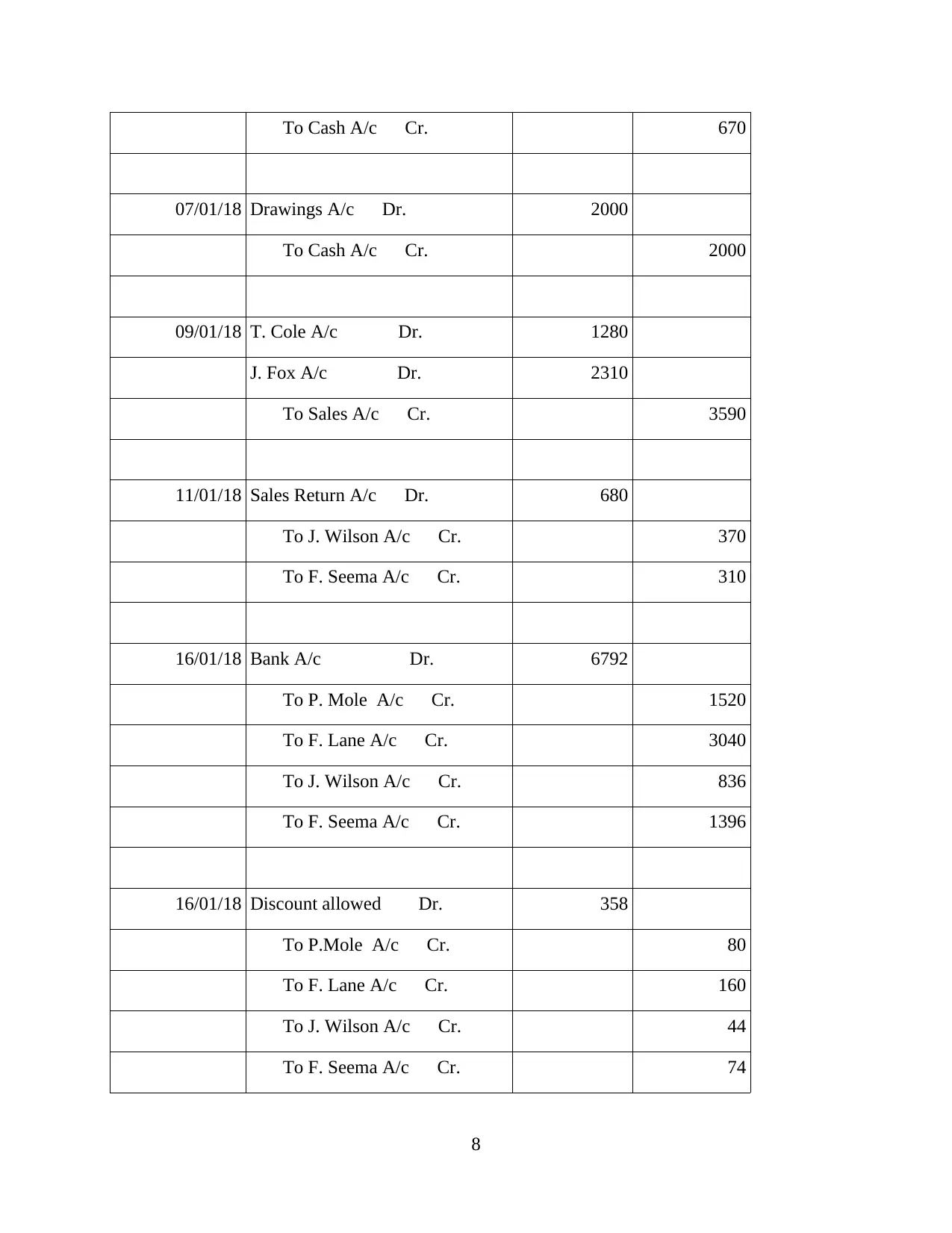
To Cash A/c Cr. 670
07/01/18 Drawings A/c Dr. 2000
To Cash A/c Cr. 2000
09/01/18 T. Cole A/c Dr. 1280
J. Fox A/c Dr. 2310
To Sales A/c Cr. 3590
11/01/18 Sales Return A/c Dr. 680
To J. Wilson A/c Cr. 370
To F. Seema A/c Cr. 310
16/01/18 Bank A/c Dr. 6792
To P. Mole A/c Cr. 1520
To F. Lane A/c Cr. 3040
To J. Wilson A/c Cr. 836
To F. Seema A/c Cr. 1396
16/01/18 Discount allowed Dr. 358
To P.Mole A/c Cr. 80
To F. Lane A/c Cr. 160
To J. Wilson A/c Cr. 44
To F. Seema A/c Cr. 74
8
07/01/18 Drawings A/c Dr. 2000
To Cash A/c Cr. 2000
09/01/18 T. Cole A/c Dr. 1280
J. Fox A/c Dr. 2310
To Sales A/c Cr. 3590
11/01/18 Sales Return A/c Dr. 680
To J. Wilson A/c Cr. 370
To F. Seema A/c Cr. 310
16/01/18 Bank A/c Dr. 6792
To P. Mole A/c Cr. 1520
To F. Lane A/c Cr. 3040
To J. Wilson A/c Cr. 836
To F. Seema A/c Cr. 1396
16/01/18 Discount allowed Dr. 358
To P.Mole A/c Cr. 80
To F. Lane A/c Cr. 160
To J. Wilson A/c Cr. 44
To F. Seema A/c Cr. 74
8

19/01/18 R Foot Dr. 110
To purchase return 110
22/01/18 Purchase A/c Dr. 3140
To L Mole a/c 1330
To W Wright 1810
24/01/18 S Hamid a/c Dr. 2340
J Brown a/c Dr. 2970
R Foot a/c Dr. 1440
To Bank a/c 6750
24/01/18 S Hamid a/c Dr. 260
J Brown a/c Dr. 330
R Foot a/c Dr. 160
To Discount Receivable a/c 750
27/01/18 Salary a/c Dr. 14500
To Bank a/c 14500
30/01/18 Business Exp a/c Dr.. 2220
To Bank a/c 2220
SALES DAY BOOK
9
To purchase return 110
22/01/18 Purchase A/c Dr. 3140
To L Mole a/c 1330
To W Wright 1810
24/01/18 S Hamid a/c Dr. 2340
J Brown a/c Dr. 2970
R Foot a/c Dr. 1440
To Bank a/c 6750
24/01/18 S Hamid a/c Dr. 260
J Brown a/c Dr. 330
R Foot a/c Dr. 160
To Discount Receivable a/c 750
27/01/18 Salary a/c Dr. 14500
To Bank a/c 14500
30/01/18 Business Exp a/c Dr.. 2220
To Bank a/c 2220
SALES DAY BOOK
9
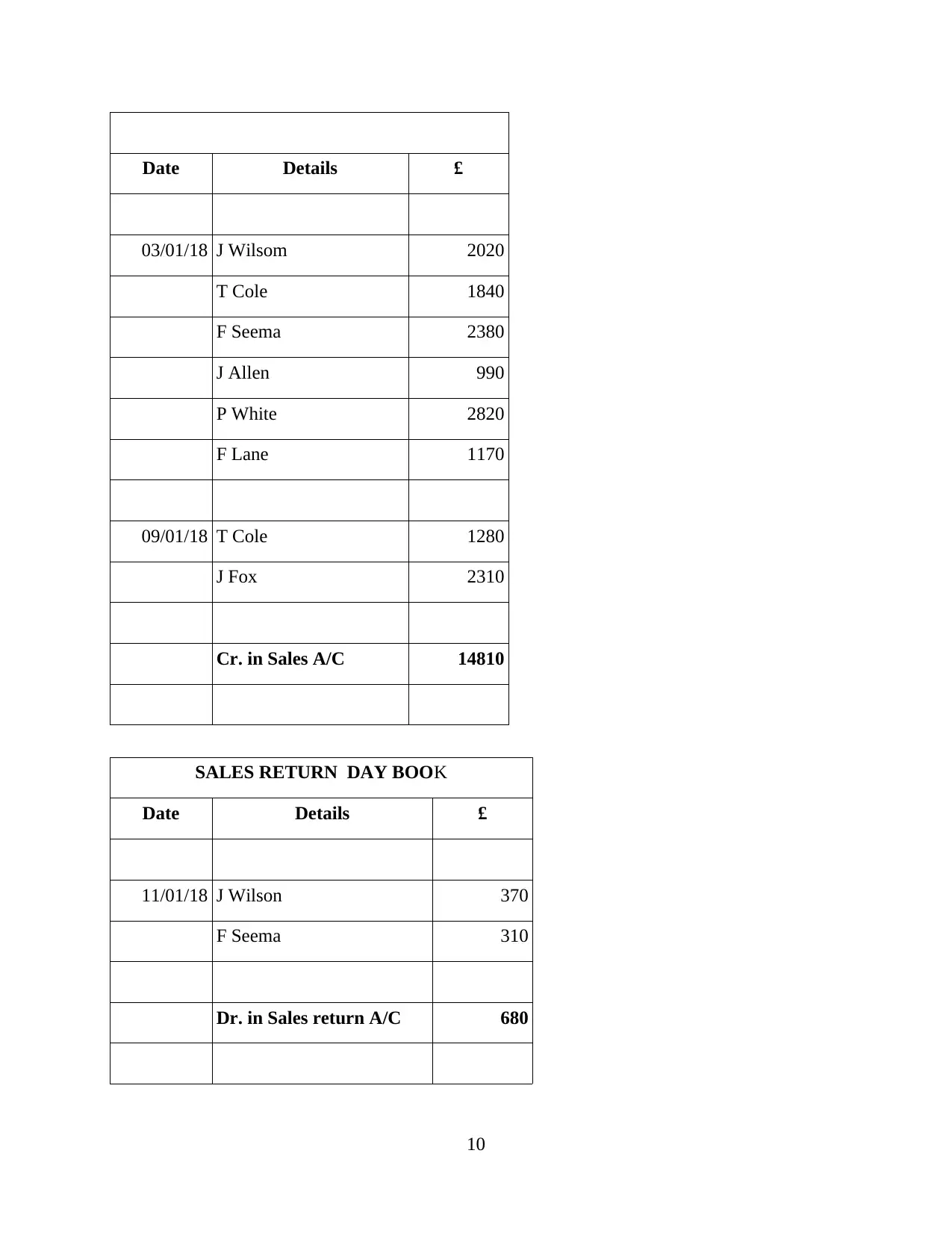
Date Details £
03/01/18 J Wilsom 2020
T Cole 1840
F Seema 2380
J Allen 990
P White 2820
F Lane 1170
09/01/18 T Cole 1280
J Fox 2310
Cr. in Sales A/C 14810
SALES RETURN DAY BOOK
Date Details £
11/01/18 J Wilson 370
F Seema 310
Dr. in Sales return A/C 680
10
03/01/18 J Wilsom 2020
T Cole 1840
F Seema 2380
J Allen 990
P White 2820
F Lane 1170
09/01/18 T Cole 1280
J Fox 2310
Cr. in Sales A/C 14810
SALES RETURN DAY BOOK
Date Details £
11/01/18 J Wilson 370
F Seema 310
Dr. in Sales return A/C 680
10
Paraphrase This Document
Need a fresh take? Get an instant paraphrase of this document with our AI Paraphraser
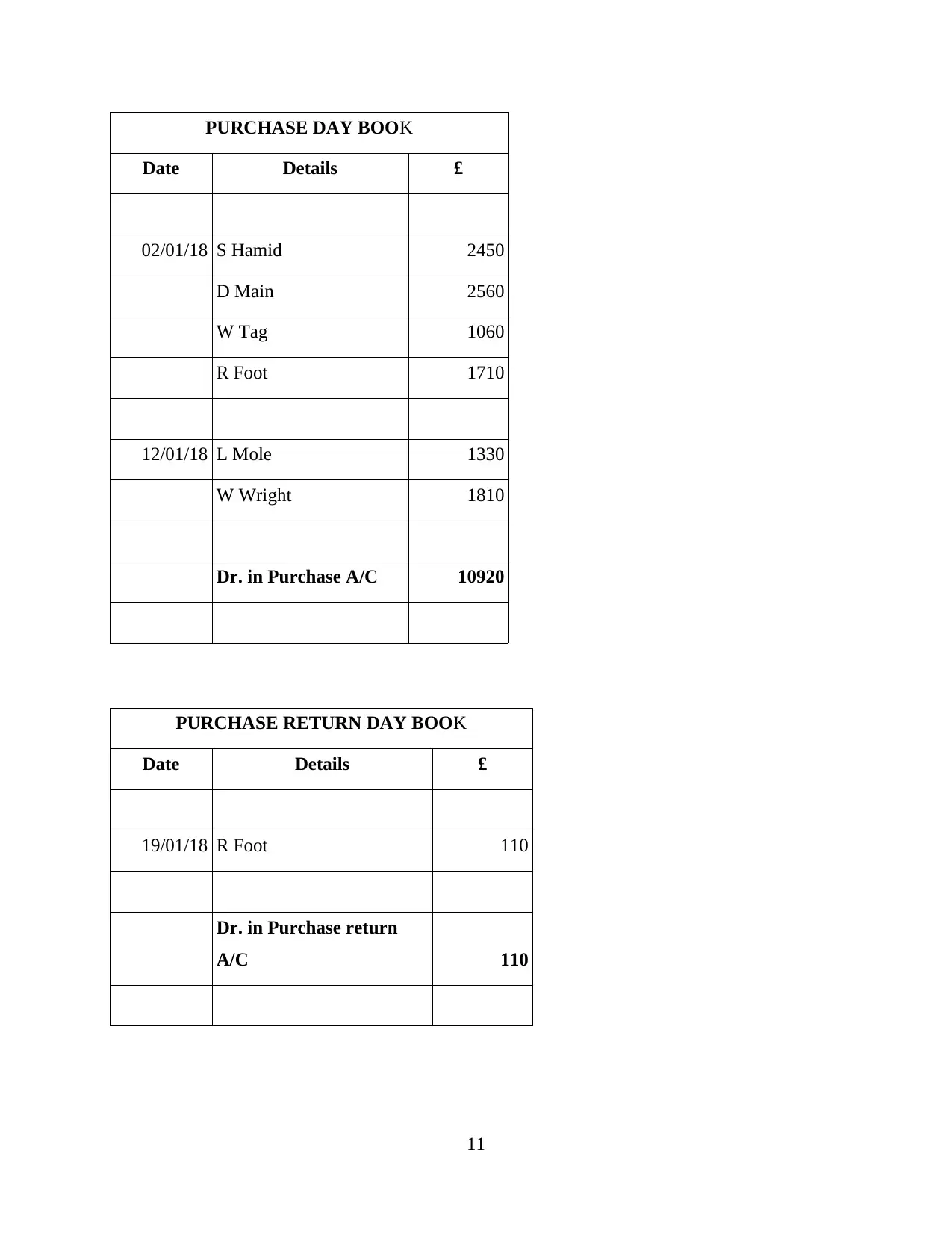
PURCHASE DAY BOOK
Date Details £
02/01/18 S Hamid 2450
D Main 2560
W Tag 1060
R Foot 1710
12/01/18 L Mole 1330
W Wright 1810
Dr. in Purchase A/C 10920
PURCHASE RETURN DAY BOOK
Date Details £
19/01/18 R Foot 110
Dr. in Purchase return
A/C 110
11
Date Details £
02/01/18 S Hamid 2450
D Main 2560
W Tag 1060
R Foot 1710
12/01/18 L Mole 1330
W Wright 1810
Dr. in Purchase A/C 10920
PURCHASE RETURN DAY BOOK
Date Details £
19/01/18 R Foot 110
Dr. in Purchase return
A/C 110
11
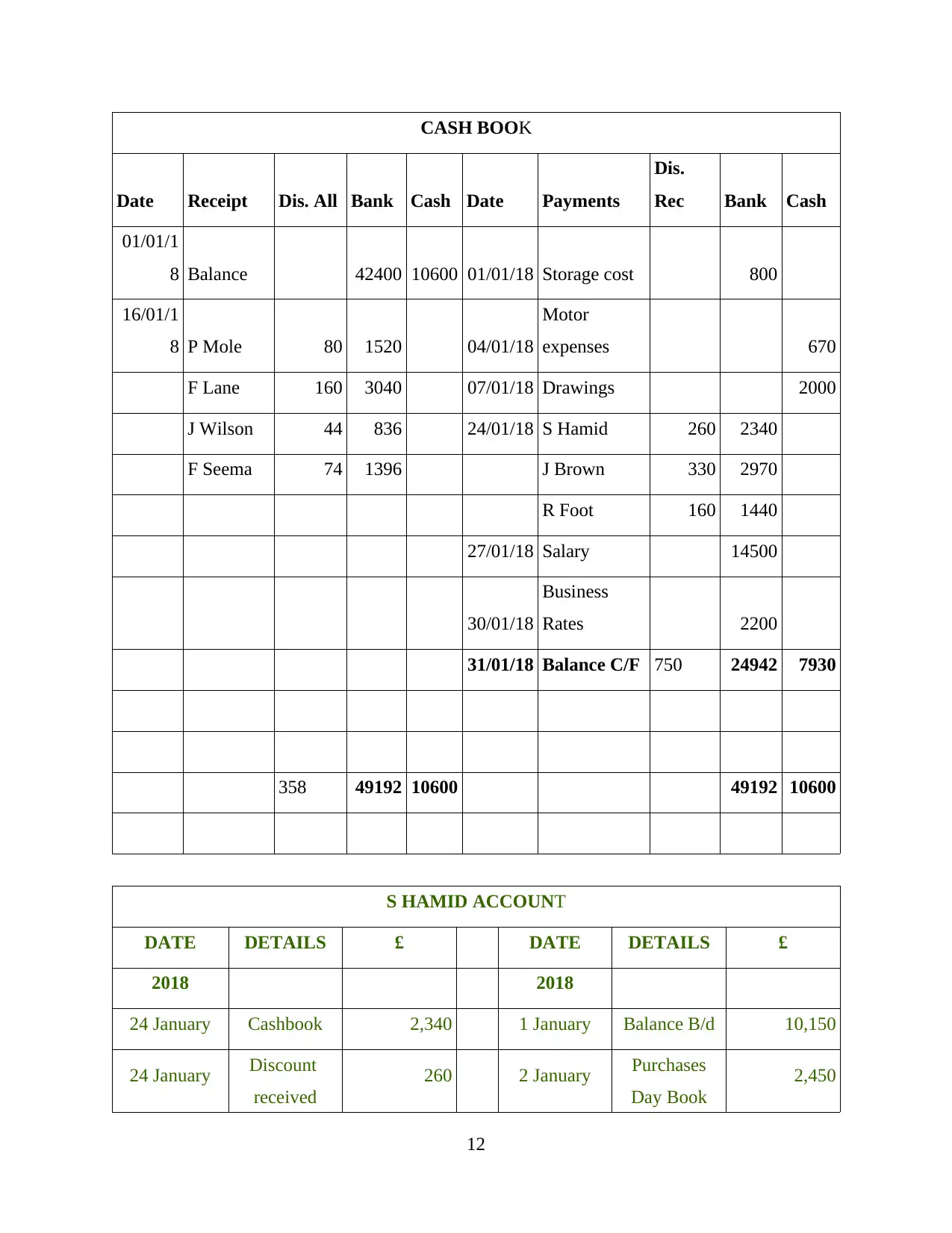
CASH BOOK
Date Receipt Dis. All Bank Cash Date Payments
Dis.
Rec Bank Cash
01/01/1
8 Balance 42400 10600 01/01/18 Storage cost 800
16/01/1
8 P Mole 80 1520 04/01/18
Motor
expenses 670
F Lane 160 3040 07/01/18 Drawings 2000
J Wilson 44 836 24/01/18 S Hamid 260 2340
F Seema 74 1396 J Brown 330 2970
R Foot 160 1440
27/01/18 Salary 14500
30/01/18
Business
Rates 2200
31/01/18 Balance C/F 750 24942 7930
358 49192 10600 49192 10600
S HAMID ACCOUNT
DATE DETAILS £ DATE DETAILS £
2018 2018
24 January Cashbook 2,340 1 January Balance B/d 10,150
24 January Discount
received
260 2 January Purchases
Day Book
2,450
12
Date Receipt Dis. All Bank Cash Date Payments
Dis.
Rec Bank Cash
01/01/1
8 Balance 42400 10600 01/01/18 Storage cost 800
16/01/1
8 P Mole 80 1520 04/01/18
Motor
expenses 670
F Lane 160 3040 07/01/18 Drawings 2000
J Wilson 44 836 24/01/18 S Hamid 260 2340
F Seema 74 1396 J Brown 330 2970
R Foot 160 1440
27/01/18 Salary 14500
30/01/18
Business
Rates 2200
31/01/18 Balance C/F 750 24942 7930
358 49192 10600 49192 10600
S HAMID ACCOUNT
DATE DETAILS £ DATE DETAILS £
2018 2018
24 January Cashbook 2,340 1 January Balance B/d 10,150
24 January Discount
received
260 2 January Purchases
Day Book
2,450
12
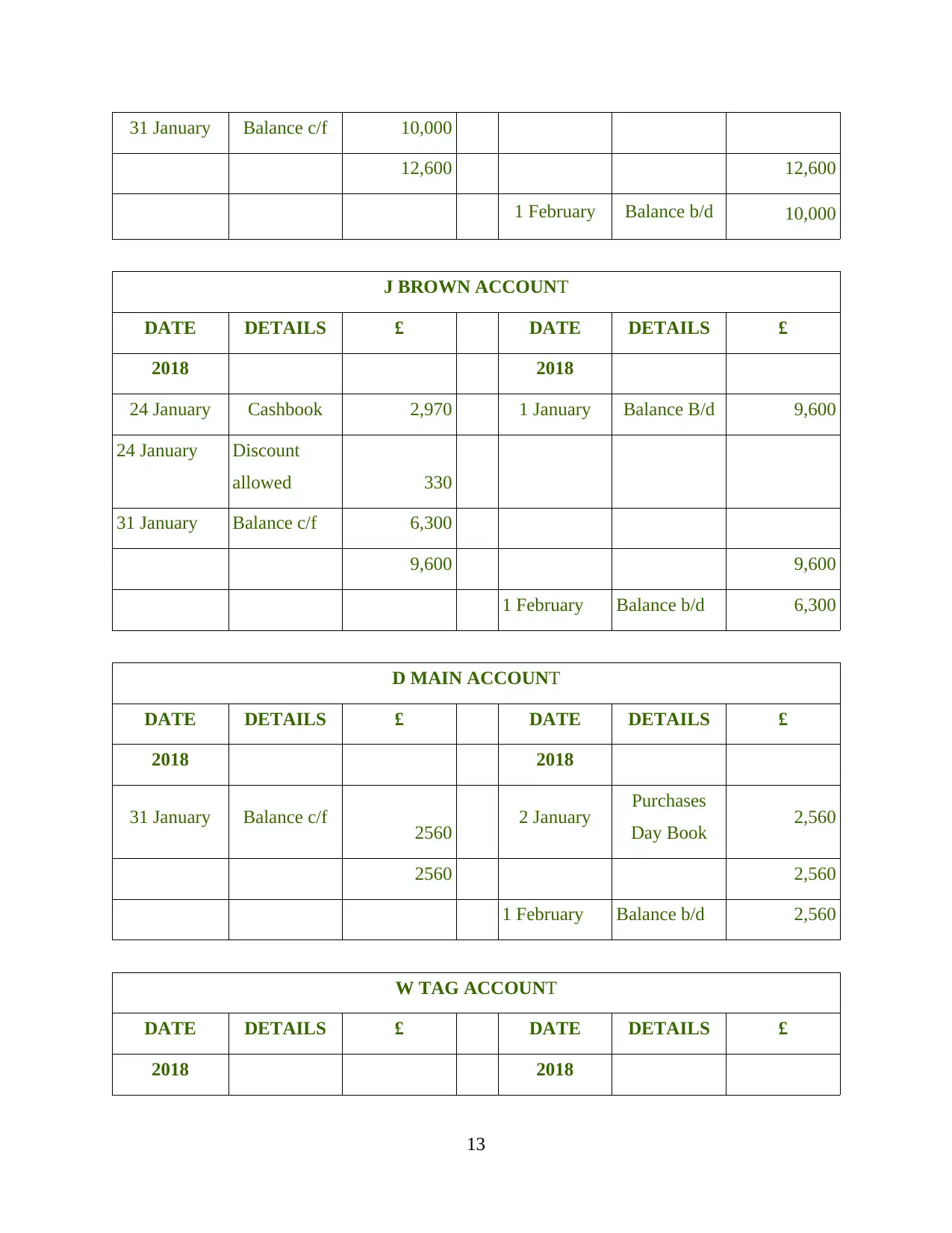
31 January Balance c/f 10,000
12,600 12,600
1 February Balance b/d 10,000
J BROWN ACCOUNT
DATE DETAILS £ DATE DETAILS £
2018 2018
24 January Cashbook 2,970 1 January Balance B/d 9,600
24 January Discount
allowed 330
31 January Balance c/f 6,300
9,600 9,600
1 February Balance b/d 6,300
D MAIN ACCOUNT
DATE DETAILS £ DATE DETAILS £
2018 2018
31 January Balance c/f 2560 2 January Purchases
Day Book 2,560
2560 2,560
1 February Balance b/d 2,560
W TAG ACCOUNT
DATE DETAILS £ DATE DETAILS £
2018 2018
13
12,600 12,600
1 February Balance b/d 10,000
J BROWN ACCOUNT
DATE DETAILS £ DATE DETAILS £
2018 2018
24 January Cashbook 2,970 1 January Balance B/d 9,600
24 January Discount
allowed 330
31 January Balance c/f 6,300
9,600 9,600
1 February Balance b/d 6,300
D MAIN ACCOUNT
DATE DETAILS £ DATE DETAILS £
2018 2018
31 January Balance c/f 2560 2 January Purchases
Day Book 2,560
2560 2,560
1 February Balance b/d 2,560
W TAG ACCOUNT
DATE DETAILS £ DATE DETAILS £
2018 2018
13
Secure Best Marks with AI Grader
Need help grading? Try our AI Grader for instant feedback on your assignments.
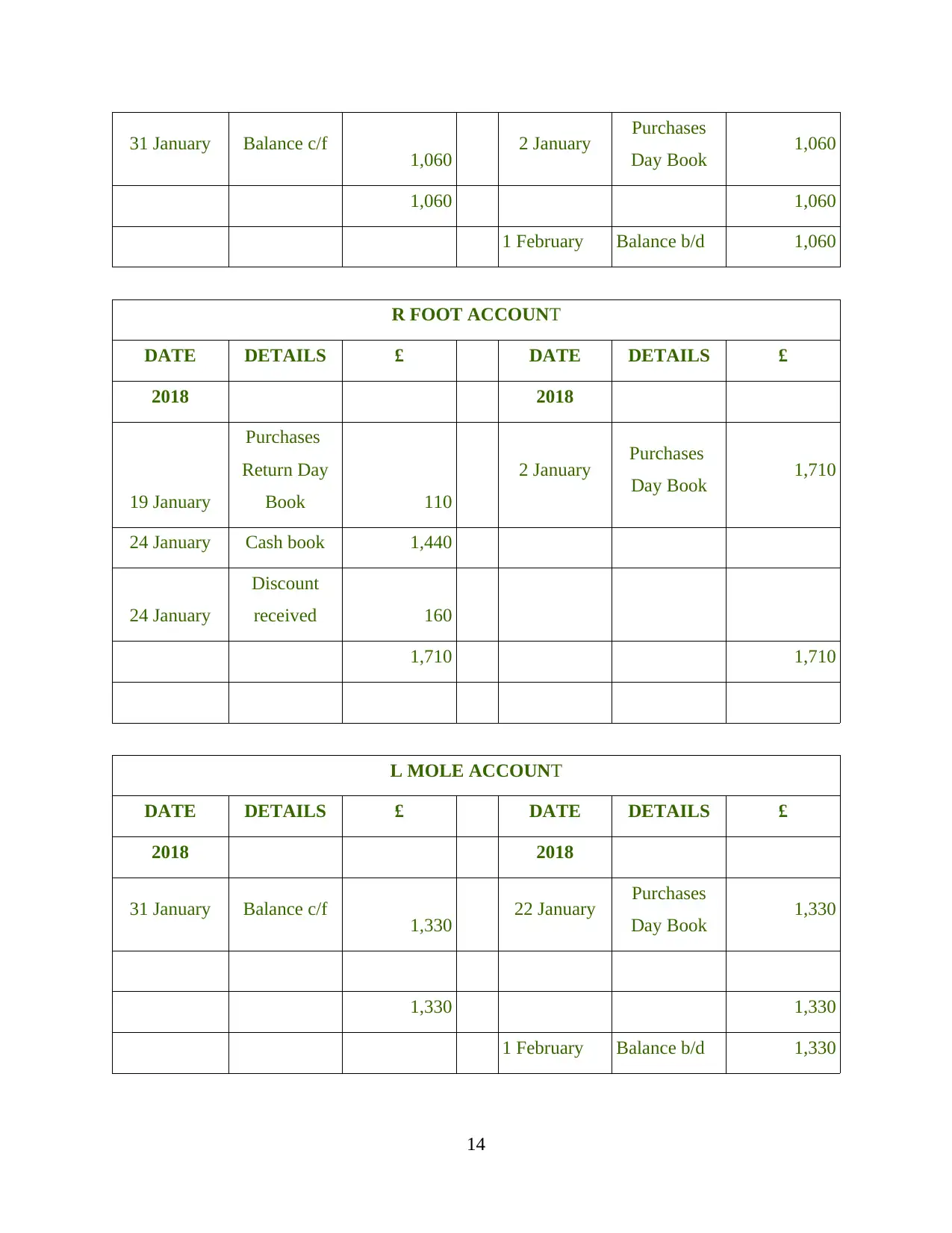
31 January Balance c/f 1,060 2 January Purchases
Day Book 1,060
1,060 1,060
1 February Balance b/d 1,060
R FOOT ACCOUNT
DATE DETAILS £ DATE DETAILS £
2018 2018
19 January
Purchases
Return Day
Book 110
2 January Purchases
Day Book 1,710
24 January Cash book 1,440
24 January
Discount
received 160
1,710 1,710
L MOLE ACCOUNT
DATE DETAILS £ DATE DETAILS £
2018 2018
31 January Balance c/f 1,330 22 January Purchases
Day Book 1,330
1,330 1,330
1 February Balance b/d 1,330
14
Day Book 1,060
1,060 1,060
1 February Balance b/d 1,060
R FOOT ACCOUNT
DATE DETAILS £ DATE DETAILS £
2018 2018
19 January
Purchases
Return Day
Book 110
2 January Purchases
Day Book 1,710
24 January Cash book 1,440
24 January
Discount
received 160
1,710 1,710
L MOLE ACCOUNT
DATE DETAILS £ DATE DETAILS £
2018 2018
31 January Balance c/f 1,330 22 January Purchases
Day Book 1,330
1,330 1,330
1 February Balance b/d 1,330
14
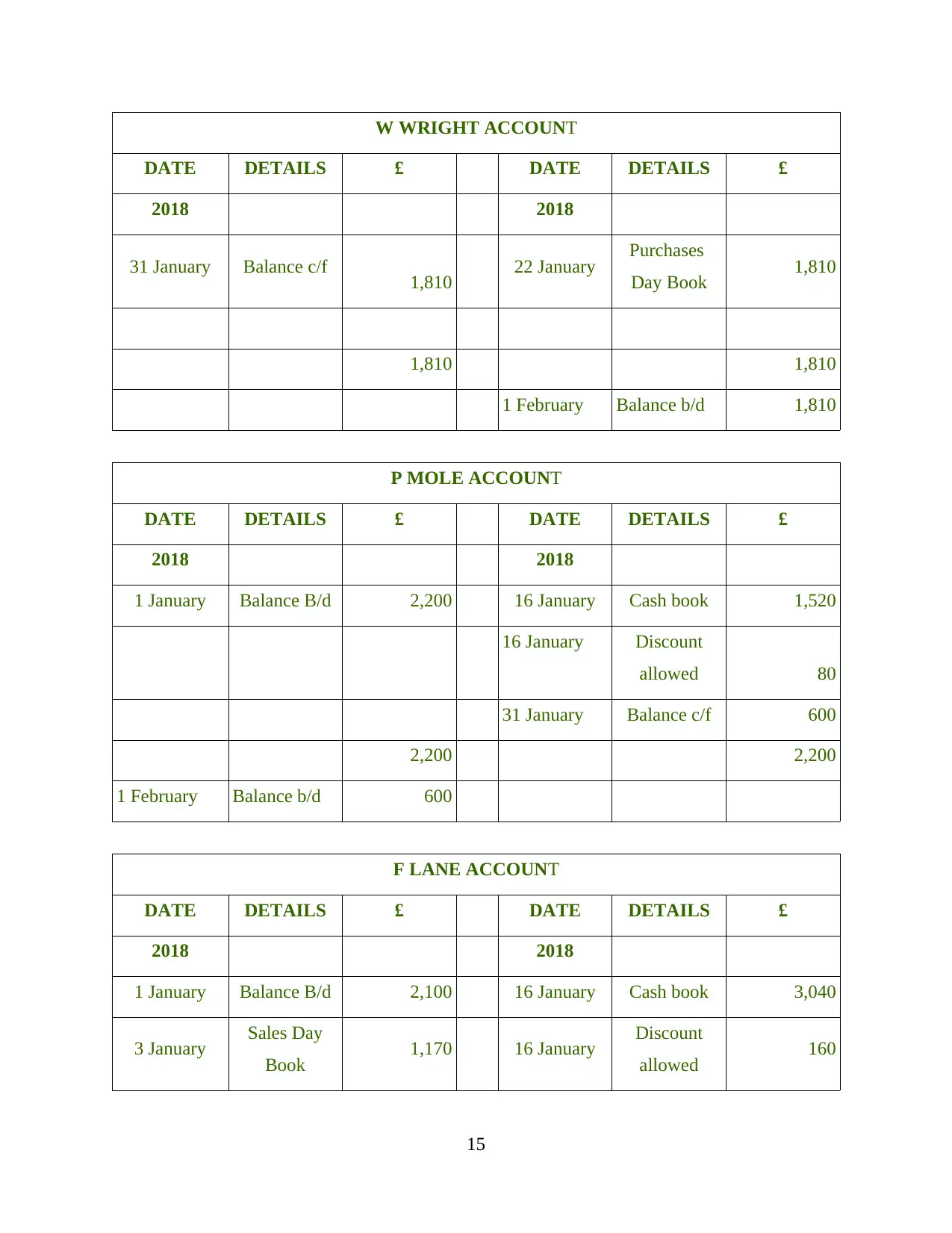
W WRIGHT ACCOUNT
DATE DETAILS £ DATE DETAILS £
2018 2018
31 January Balance c/f 1,810 22 January Purchases
Day Book 1,810
1,810 1,810
1 February Balance b/d 1,810
P MOLE ACCOUNT
DATE DETAILS £ DATE DETAILS £
2018 2018
1 January Balance B/d 2,200 16 January Cash book 1,520
16 January Discount
allowed 80
31 January Balance c/f 600
2,200 2,200
1 February Balance b/d 600
F LANE ACCOUNT
DATE DETAILS £ DATE DETAILS £
2018 2018
1 January Balance B/d 2,100 16 January Cash book 3,040
3 January Sales Day
Book 1,170 16 January Discount
allowed 160
15
DATE DETAILS £ DATE DETAILS £
2018 2018
31 January Balance c/f 1,810 22 January Purchases
Day Book 1,810
1,810 1,810
1 February Balance b/d 1,810
P MOLE ACCOUNT
DATE DETAILS £ DATE DETAILS £
2018 2018
1 January Balance B/d 2,200 16 January Cash book 1,520
16 January Discount
allowed 80
31 January Balance c/f 600
2,200 2,200
1 February Balance b/d 600
F LANE ACCOUNT
DATE DETAILS £ DATE DETAILS £
2018 2018
1 January Balance B/d 2,100 16 January Cash book 3,040
3 January Sales Day
Book 1,170 16 January Discount
allowed 160
15
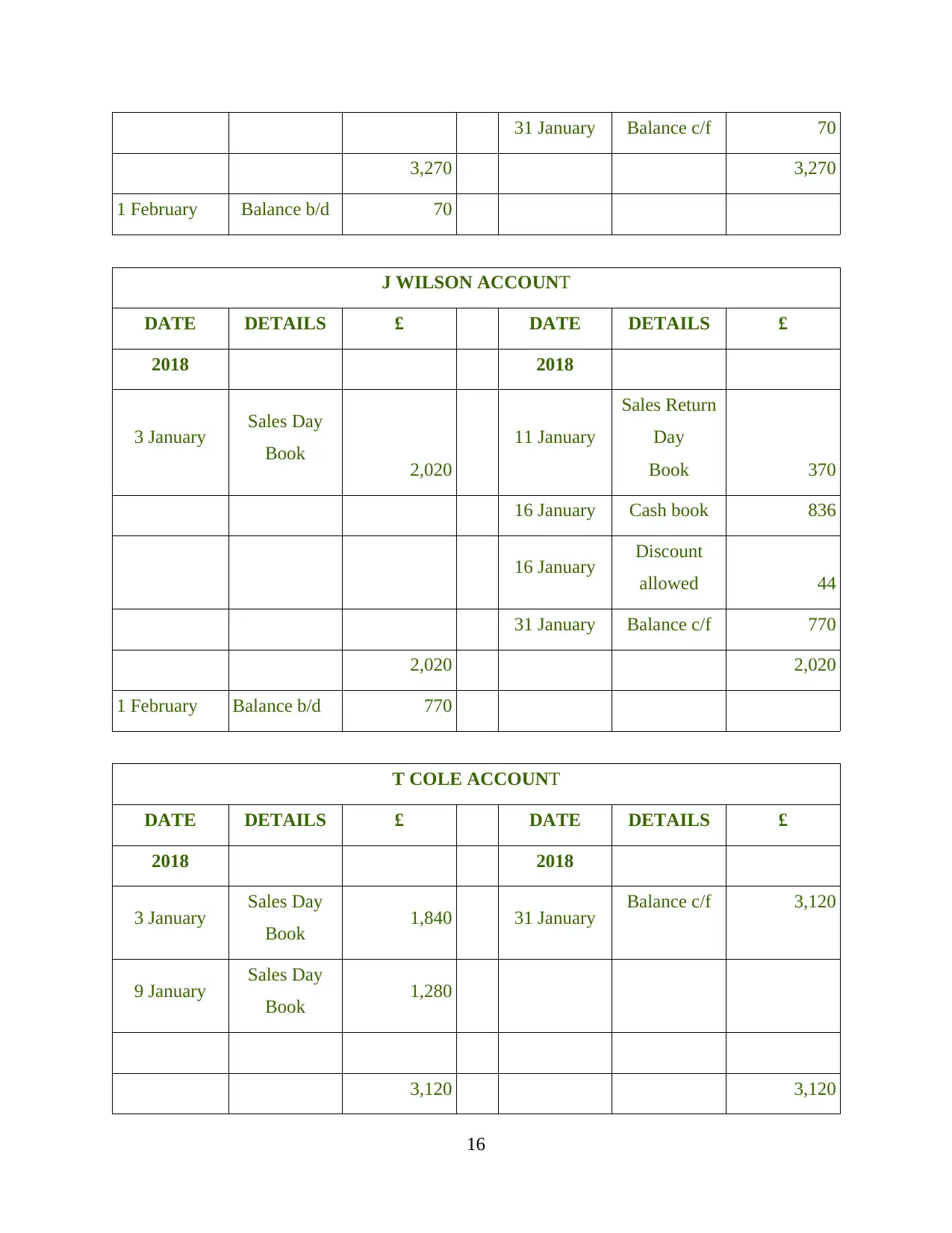
31 January Balance c/f 70
3,270 3,270
1 February Balance b/d 70
J WILSON ACCOUNT
DATE DETAILS £ DATE DETAILS £
2018 2018
3 January Sales Day
Book 2,020
11 January
Sales Return
Day
Book 370
16 January Cash book 836
16 January Discount
allowed 44
31 January Balance c/f 770
2,020 2,020
1 February Balance b/d 770
T COLE ACCOUNT
DATE DETAILS £ DATE DETAILS £
2018 2018
3 January Sales Day
Book 1,840 31 January Balance c/f 3,120
9 January Sales Day
Book 1,280
3,120 3,120
16
3,270 3,270
1 February Balance b/d 70
J WILSON ACCOUNT
DATE DETAILS £ DATE DETAILS £
2018 2018
3 January Sales Day
Book 2,020
11 January
Sales Return
Day
Book 370
16 January Cash book 836
16 January Discount
allowed 44
31 January Balance c/f 770
2,020 2,020
1 February Balance b/d 770
T COLE ACCOUNT
DATE DETAILS £ DATE DETAILS £
2018 2018
3 January Sales Day
Book 1,840 31 January Balance c/f 3,120
9 January Sales Day
Book 1,280
3,120 3,120
16
Paraphrase This Document
Need a fresh take? Get an instant paraphrase of this document with our AI Paraphraser
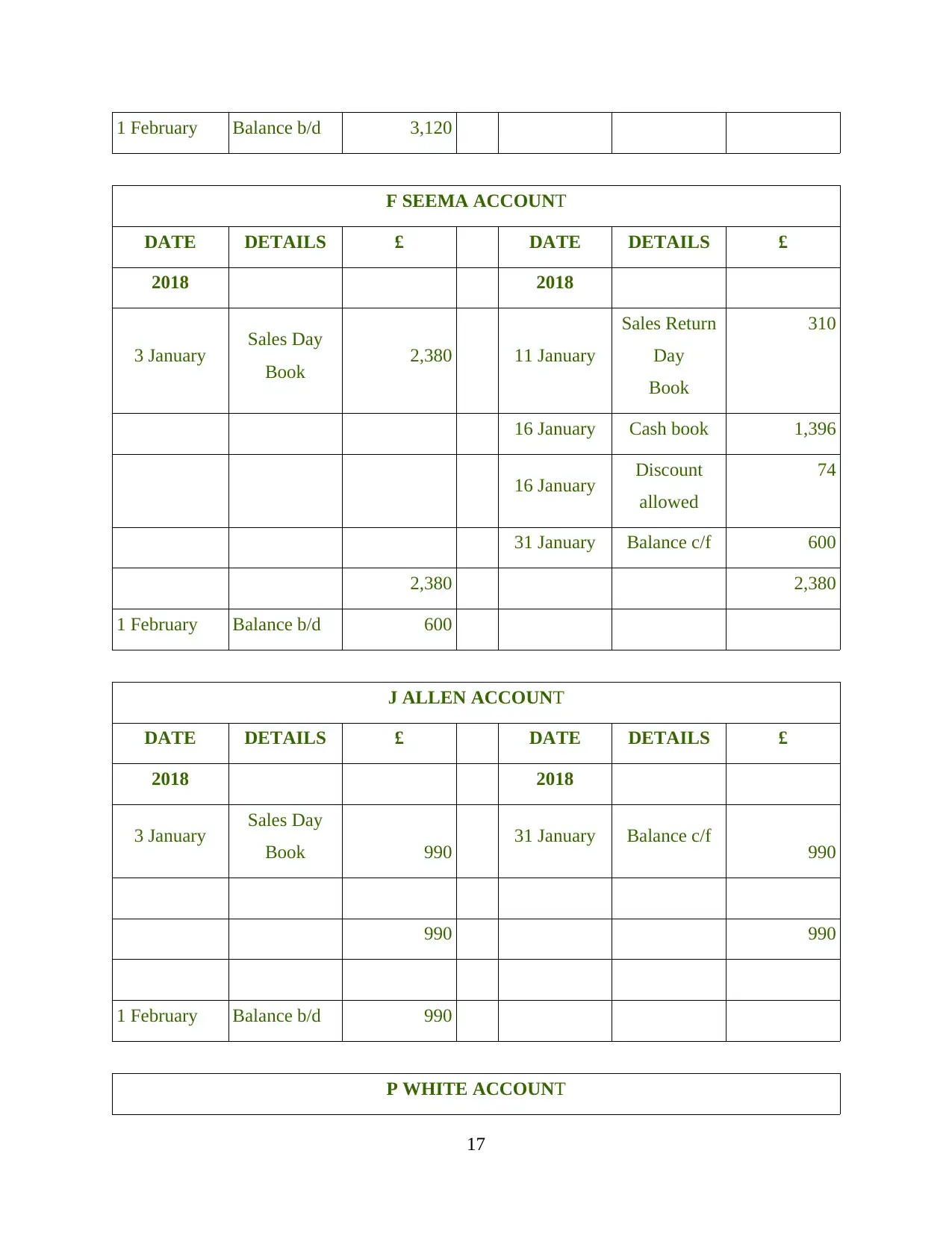
1 February Balance b/d 3,120
F SEEMA ACCOUNT
DATE DETAILS £ DATE DETAILS £
2018 2018
3 January Sales Day
Book 2,380 11 January
Sales Return
Day
Book
310
16 January Cash book 1,396
16 January Discount
allowed
74
31 January Balance c/f 600
2,380 2,380
1 February Balance b/d 600
J ALLEN ACCOUNT
DATE DETAILS £ DATE DETAILS £
2018 2018
3 January Sales Day
Book 990 31 January Balance c/f 990
990 990
1 February Balance b/d 990
P WHITE ACCOUNT
17
F SEEMA ACCOUNT
DATE DETAILS £ DATE DETAILS £
2018 2018
3 January Sales Day
Book 2,380 11 January
Sales Return
Day
Book
310
16 January Cash book 1,396
16 January Discount
allowed
74
31 January Balance c/f 600
2,380 2,380
1 February Balance b/d 600
J ALLEN ACCOUNT
DATE DETAILS £ DATE DETAILS £
2018 2018
3 January Sales Day
Book 990 31 January Balance c/f 990
990 990
1 February Balance b/d 990
P WHITE ACCOUNT
17
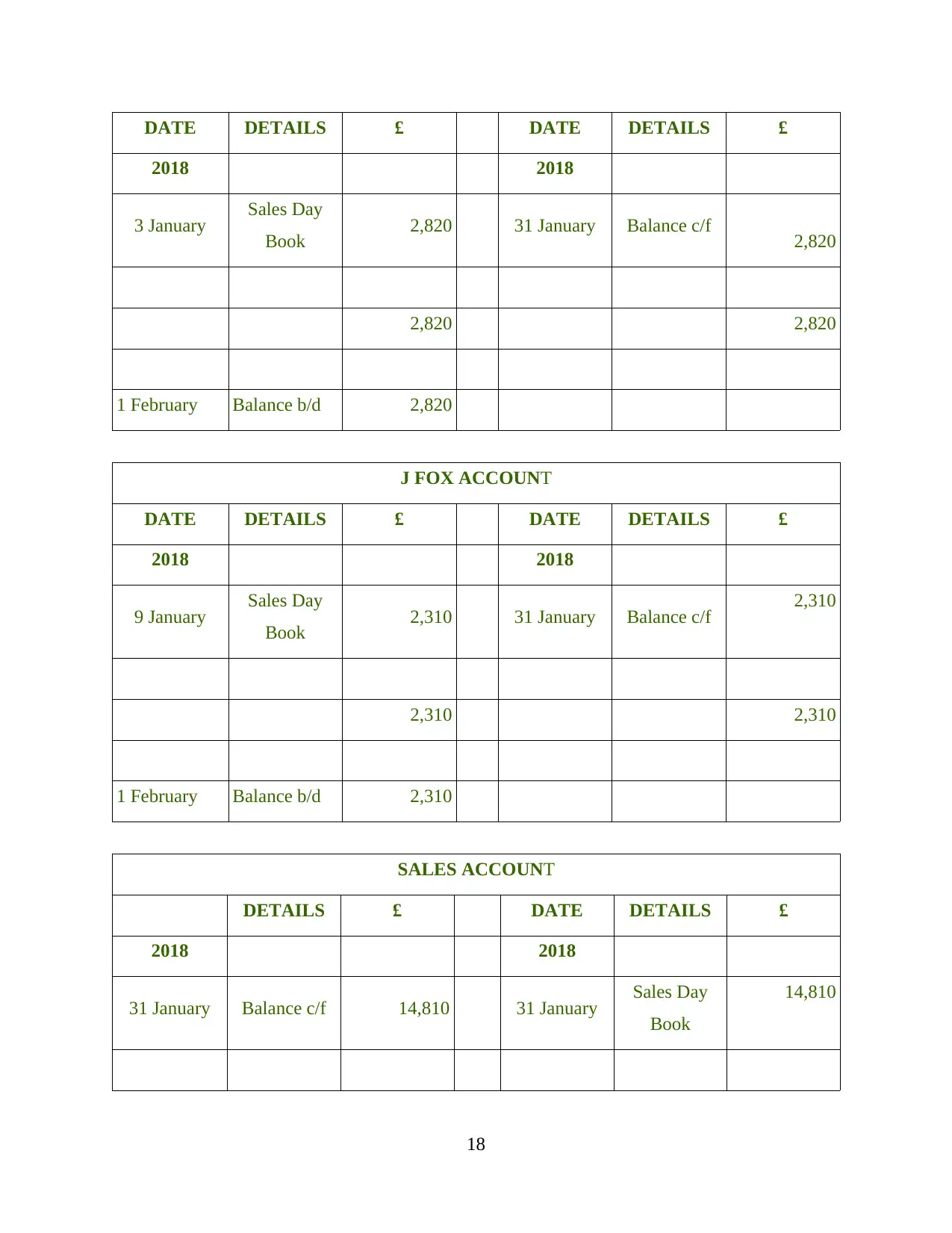
DATE DETAILS £ DATE DETAILS £
2018 2018
3 January Sales Day
Book 2,820 31 January Balance c/f 2,820
2,820 2,820
1 February Balance b/d 2,820
J FOX ACCOUNT
DATE DETAILS £ DATE DETAILS £
2018 2018
9 January Sales Day
Book 2,310 31 January Balance c/f 2,310
2,310 2,310
1 February Balance b/d 2,310
SALES ACCOUNT
DETAILS £ DATE DETAILS £
2018 2018
31 January Balance c/f 14,810 31 January Sales Day
Book
14,810
18
2018 2018
3 January Sales Day
Book 2,820 31 January Balance c/f 2,820
2,820 2,820
1 February Balance b/d 2,820
J FOX ACCOUNT
DATE DETAILS £ DATE DETAILS £
2018 2018
9 January Sales Day
Book 2,310 31 January Balance c/f 2,310
2,310 2,310
1 February Balance b/d 2,310
SALES ACCOUNT
DETAILS £ DATE DETAILS £
2018 2018
31 January Balance c/f 14,810 31 January Sales Day
Book
14,810
18
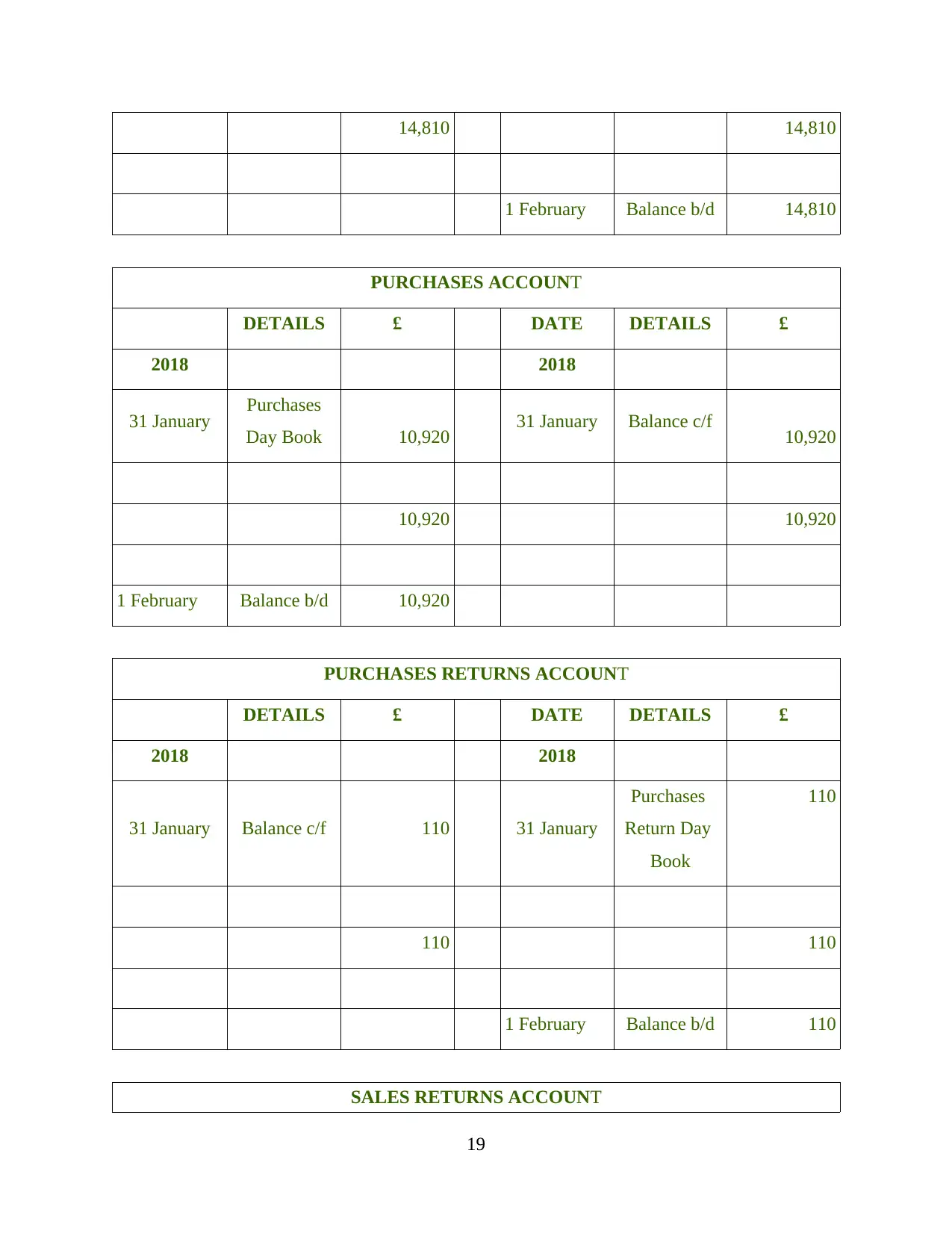
14,810 14,810
1 February Balance b/d 14,810
PURCHASES ACCOUNT
DETAILS £ DATE DETAILS £
2018 2018
31 January Purchases
Day Book 10,920 31 January Balance c/f 10,920
10,920 10,920
1 February Balance b/d 10,920
PURCHASES RETURNS ACCOUNT
DETAILS £ DATE DETAILS £
2018 2018
31 January Balance c/f 110 31 January
Purchases
Return Day
Book
110
110 110
1 February Balance b/d 110
SALES RETURNS ACCOUNT
19
1 February Balance b/d 14,810
PURCHASES ACCOUNT
DETAILS £ DATE DETAILS £
2018 2018
31 January Purchases
Day Book 10,920 31 January Balance c/f 10,920
10,920 10,920
1 February Balance b/d 10,920
PURCHASES RETURNS ACCOUNT
DETAILS £ DATE DETAILS £
2018 2018
31 January Balance c/f 110 31 January
Purchases
Return Day
Book
110
110 110
1 February Balance b/d 110
SALES RETURNS ACCOUNT
19
Secure Best Marks with AI Grader
Need help grading? Try our AI Grader for instant feedback on your assignments.
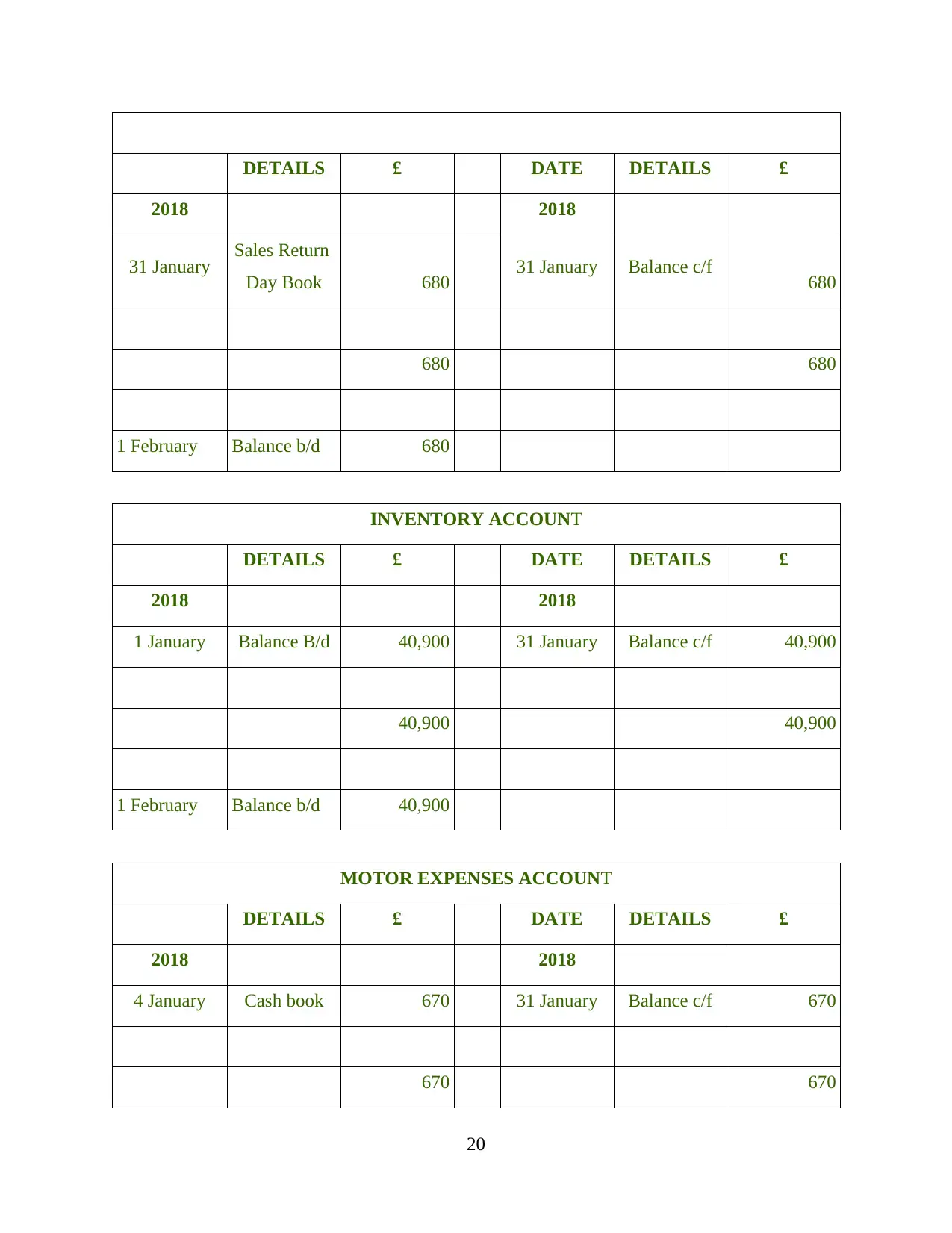
DETAILS £ DATE DETAILS £
2018 2018
31 January Sales Return
Day Book 680 31 January Balance c/f 680
680 680
1 February Balance b/d 680
INVENTORY ACCOUNT
DETAILS £ DATE DETAILS £
2018 2018
1 January Balance B/d 40,900 31 January Balance c/f 40,900
40,900 40,900
1 February Balance b/d 40,900
MOTOR EXPENSES ACCOUNT
DETAILS £ DATE DETAILS £
2018 2018
4 January Cash book 670 31 January Balance c/f 670
670 670
20
2018 2018
31 January Sales Return
Day Book 680 31 January Balance c/f 680
680 680
1 February Balance b/d 680
INVENTORY ACCOUNT
DETAILS £ DATE DETAILS £
2018 2018
1 January Balance B/d 40,900 31 January Balance c/f 40,900
40,900 40,900
1 February Balance b/d 40,900
MOTOR EXPENSES ACCOUNT
DETAILS £ DATE DETAILS £
2018 2018
4 January Cash book 670 31 January Balance c/f 670
670 670
20
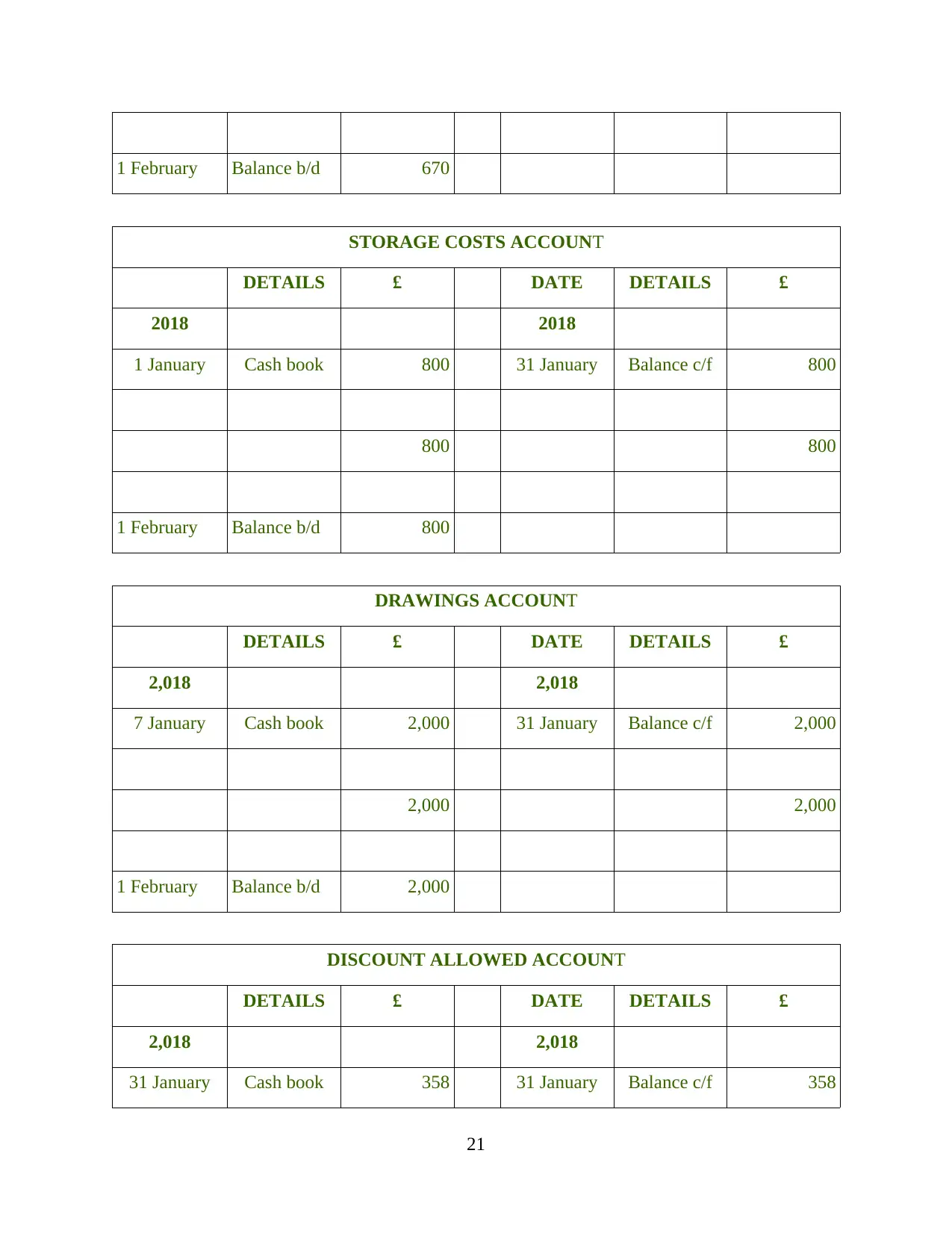
1 February Balance b/d 670
STORAGE COSTS ACCOUNT
DETAILS £ DATE DETAILS £
2018 2018
1 January Cash book 800 31 January Balance c/f 800
800 800
1 February Balance b/d 800
DRAWINGS ACCOUNT
DETAILS £ DATE DETAILS £
2,018 2,018
7 January Cash book 2,000 31 January Balance c/f 2,000
2,000 2,000
1 February Balance b/d 2,000
DISCOUNT ALLOWED ACCOUNT
DETAILS £ DATE DETAILS £
2,018 2,018
31 January Cash book 358 31 January Balance c/f 358
21
STORAGE COSTS ACCOUNT
DETAILS £ DATE DETAILS £
2018 2018
1 January Cash book 800 31 January Balance c/f 800
800 800
1 February Balance b/d 800
DRAWINGS ACCOUNT
DETAILS £ DATE DETAILS £
2,018 2,018
7 January Cash book 2,000 31 January Balance c/f 2,000
2,000 2,000
1 February Balance b/d 2,000
DISCOUNT ALLOWED ACCOUNT
DETAILS £ DATE DETAILS £
2,018 2,018
31 January Cash book 358 31 January Balance c/f 358
21
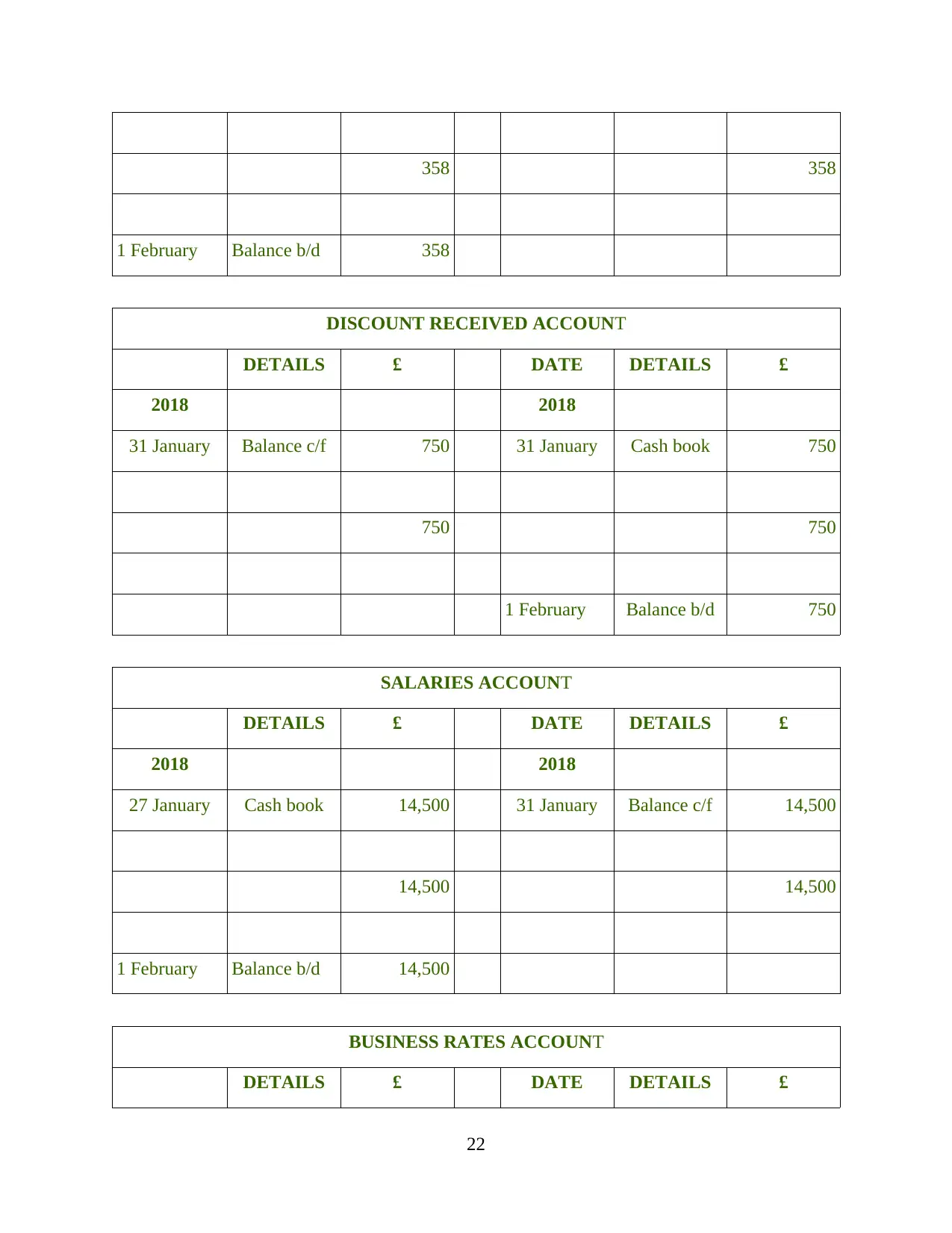
358 358
1 February Balance b/d 358
DISCOUNT RECEIVED ACCOUNT
DETAILS £ DATE DETAILS £
2018 2018
31 January Balance c/f 750 31 January Cash book 750
750 750
1 February Balance b/d 750
SALARIES ACCOUNT
DETAILS £ DATE DETAILS £
2018 2018
27 January Cash book 14,500 31 January Balance c/f 14,500
14,500 14,500
1 February Balance b/d 14,500
BUSINESS RATES ACCOUNT
DETAILS £ DATE DETAILS £
22
1 February Balance b/d 358
DISCOUNT RECEIVED ACCOUNT
DETAILS £ DATE DETAILS £
2018 2018
31 January Balance c/f 750 31 January Cash book 750
750 750
1 February Balance b/d 750
SALARIES ACCOUNT
DETAILS £ DATE DETAILS £
2018 2018
27 January Cash book 14,500 31 January Balance c/f 14,500
14,500 14,500
1 February Balance b/d 14,500
BUSINESS RATES ACCOUNT
DETAILS £ DATE DETAILS £
22
Paraphrase This Document
Need a fresh take? Get an instant paraphrase of this document with our AI Paraphraser

2018 2018
30 January Cash book 2,220 31 January Balance c/f 2,220
2,220 2,220
1 February Balance b/d 2,220
CAPITAL ACCOUNT
DETAILS £ DATE DETAILS £
2018 2018
31 January Balance c/f 5,73,800 1 January Balance b/d 5,73,800
5,73,800 5,73,800
1 February Balance b/d 5,73,800
VAN ACCOUNT
DETAILS £ DATE DETAILS £
2018 2018
1 January Balance b/d 45,250 31 January Balance c/f 45,250
45,250 45,250
1 February Balance b/d 45,250
23
30 January Cash book 2,220 31 January Balance c/f 2,220
2,220 2,220
1 February Balance b/d 2,220
CAPITAL ACCOUNT
DETAILS £ DATE DETAILS £
2018 2018
31 January Balance c/f 5,73,800 1 January Balance b/d 5,73,800
5,73,800 5,73,800
1 February Balance b/d 5,73,800
VAN ACCOUNT
DETAILS £ DATE DETAILS £
2018 2018
1 January Balance b/d 45,250 31 January Balance c/f 45,250
45,250 45,250
1 February Balance b/d 45,250
23
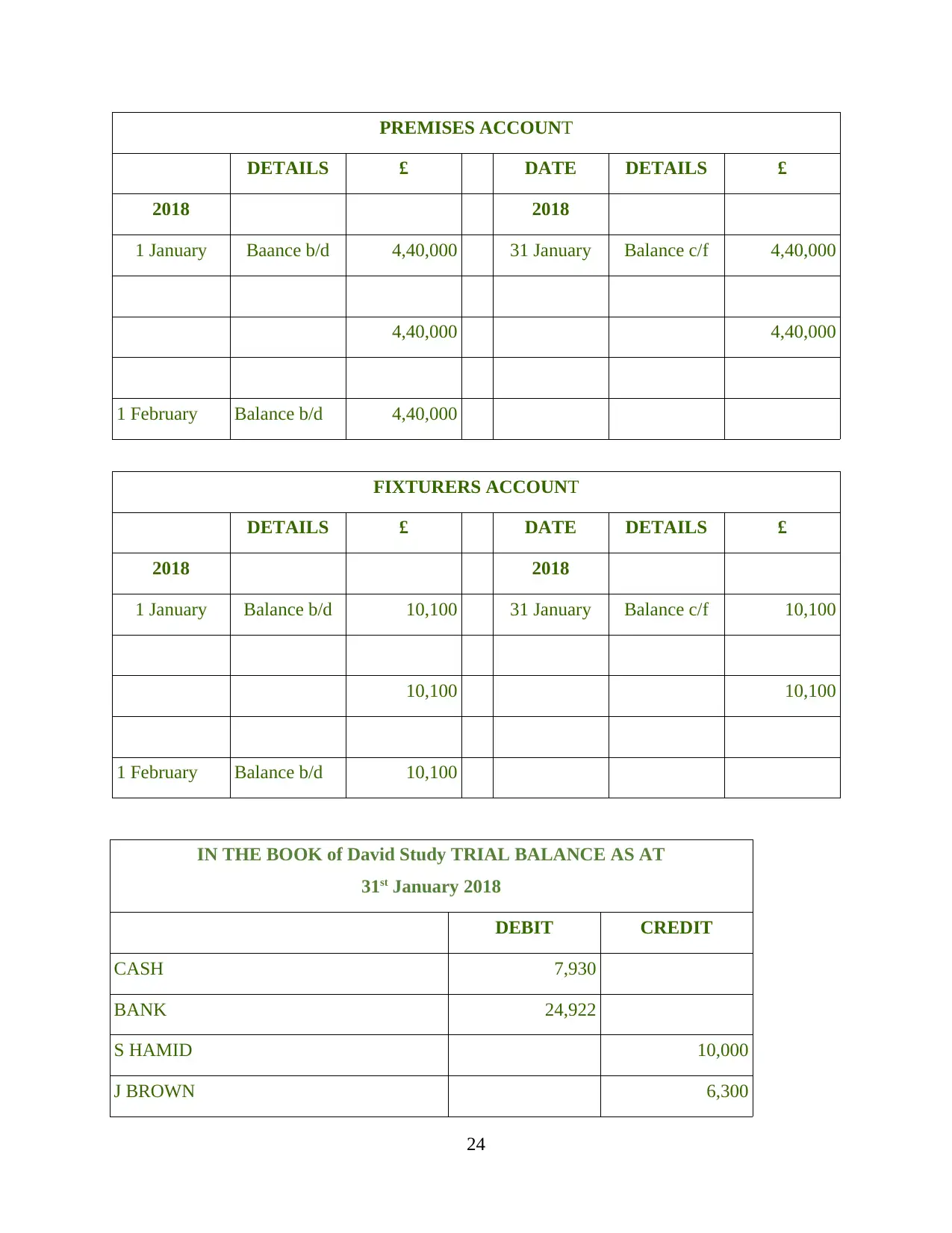
PREMISES ACCOUNT
DETAILS £ DATE DETAILS £
2018 2018
1 January Baance b/d 4,40,000 31 January Balance c/f 4,40,000
4,40,000 4,40,000
1 February Balance b/d 4,40,000
FIXTURERS ACCOUNT
DETAILS £ DATE DETAILS £
2018 2018
1 January Balance b/d 10,100 31 January Balance c/f 10,100
10,100 10,100
1 February Balance b/d 10,100
IN THE BOOK of David Study TRIAL BALANCE AS AT
31st January 2018
DEBIT CREDIT
CASH 7,930
BANK 24,922
S HAMID 10,000
J BROWN 6,300
24
DETAILS £ DATE DETAILS £
2018 2018
1 January Baance b/d 4,40,000 31 January Balance c/f 4,40,000
4,40,000 4,40,000
1 February Balance b/d 4,40,000
FIXTURERS ACCOUNT
DETAILS £ DATE DETAILS £
2018 2018
1 January Balance b/d 10,100 31 January Balance c/f 10,100
10,100 10,100
1 February Balance b/d 10,100
IN THE BOOK of David Study TRIAL BALANCE AS AT
31st January 2018
DEBIT CREDIT
CASH 7,930
BANK 24,922
S HAMID 10,000
J BROWN 6,300
24
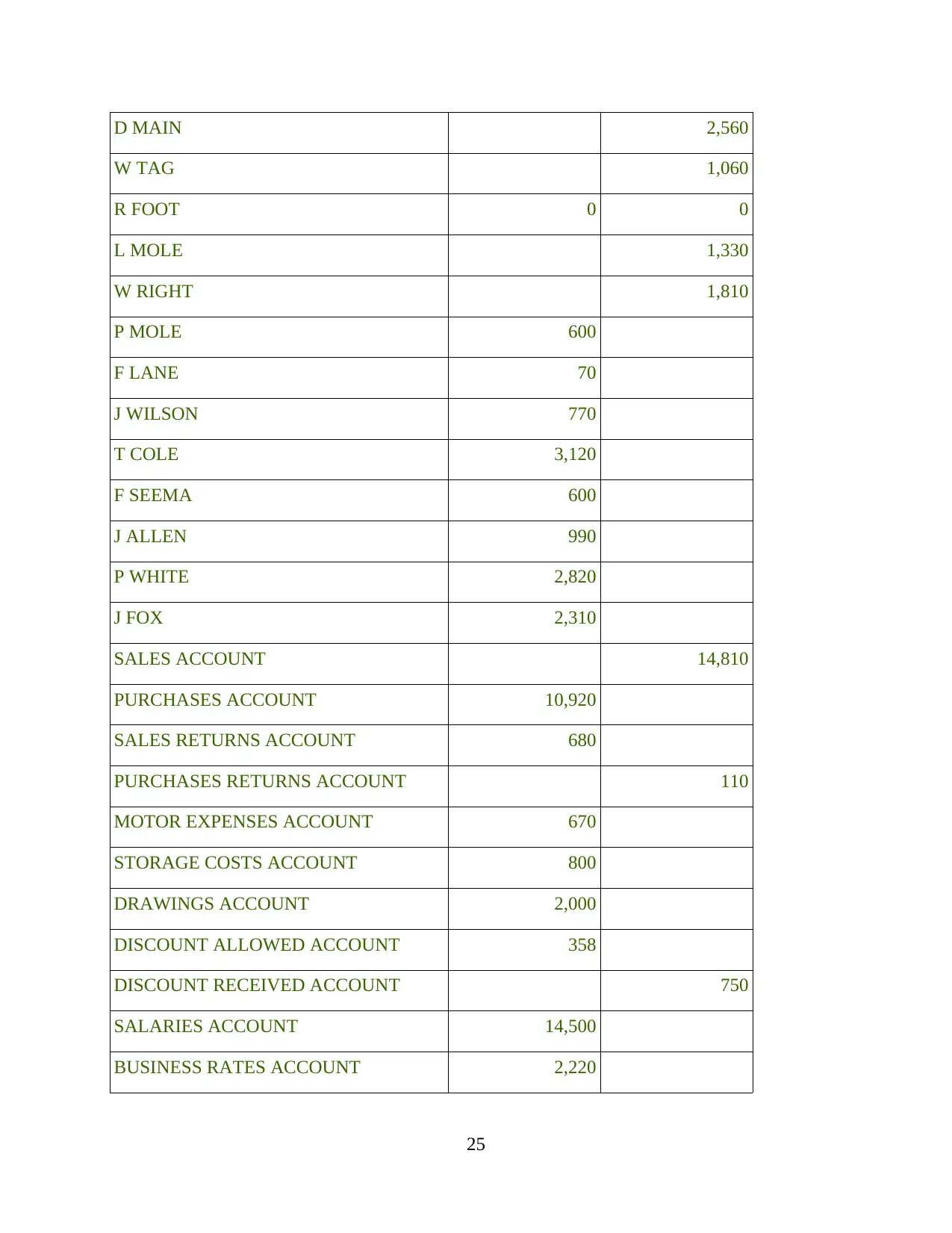
D MAIN 2,560
W TAG 1,060
R FOOT 0 0
L MOLE 1,330
W RIGHT 1,810
P MOLE 600
F LANE 70
J WILSON 770
T COLE 3,120
F SEEMA 600
J ALLEN 990
P WHITE 2,820
J FOX 2,310
SALES ACCOUNT 14,810
PURCHASES ACCOUNT 10,920
SALES RETURNS ACCOUNT 680
PURCHASES RETURNS ACCOUNT 110
MOTOR EXPENSES ACCOUNT 670
STORAGE COSTS ACCOUNT 800
DRAWINGS ACCOUNT 2,000
DISCOUNT ALLOWED ACCOUNT 358
DISCOUNT RECEIVED ACCOUNT 750
SALARIES ACCOUNT 14,500
BUSINESS RATES ACCOUNT 2,220
25
W TAG 1,060
R FOOT 0 0
L MOLE 1,330
W RIGHT 1,810
P MOLE 600
F LANE 70
J WILSON 770
T COLE 3,120
F SEEMA 600
J ALLEN 990
P WHITE 2,820
J FOX 2,310
SALES ACCOUNT 14,810
PURCHASES ACCOUNT 10,920
SALES RETURNS ACCOUNT 680
PURCHASES RETURNS ACCOUNT 110
MOTOR EXPENSES ACCOUNT 670
STORAGE COSTS ACCOUNT 800
DRAWINGS ACCOUNT 2,000
DISCOUNT ALLOWED ACCOUNT 358
DISCOUNT RECEIVED ACCOUNT 750
SALARIES ACCOUNT 14,500
BUSINESS RATES ACCOUNT 2,220
25
Secure Best Marks with AI Grader
Need help grading? Try our AI Grader for instant feedback on your assignments.
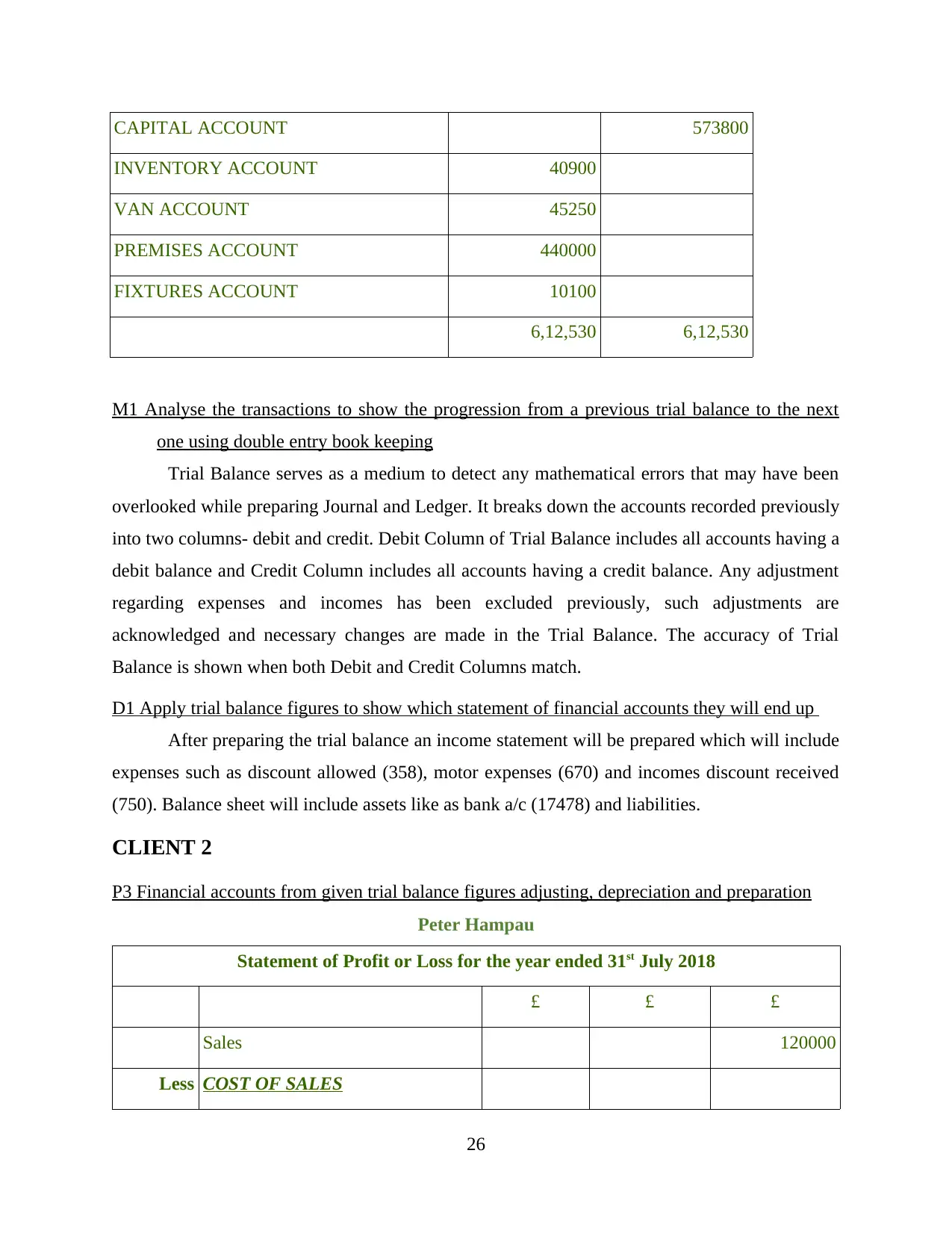
CAPITAL ACCOUNT 573800
INVENTORY ACCOUNT 40900
VAN ACCOUNT 45250
PREMISES ACCOUNT 440000
FIXTURES ACCOUNT 10100
6,12,530 6,12,530
M1 Analyse the transactions to show the progression from a previous trial balance to the next
one using double entry book keeping
Trial Balance serves as a medium to detect any mathematical errors that may have been
overlooked while preparing Journal and Ledger. It breaks down the accounts recorded previously
into two columns- debit and credit. Debit Column of Trial Balance includes all accounts having a
debit balance and Credit Column includes all accounts having a credit balance. Any adjustment
regarding expenses and incomes has been excluded previously, such adjustments are
acknowledged and necessary changes are made in the Trial Balance. The accuracy of Trial
Balance is shown when both Debit and Credit Columns match.
D1 Apply trial balance figures to show which statement of financial accounts they will end up
After preparing the trial balance an income statement will be prepared which will include
expenses such as discount allowed (358), motor expenses (670) and incomes discount received
(750). Balance sheet will include assets like as bank a/c (17478) and liabilities.
CLIENT 2
P3 Financial accounts from given trial balance figures adjusting, depreciation and preparation
Peter Hampau
Statement of Profit or Loss for the year ended 31st July 2018
£ £ £
Sales 120000
Less COST OF SALES
26
INVENTORY ACCOUNT 40900
VAN ACCOUNT 45250
PREMISES ACCOUNT 440000
FIXTURES ACCOUNT 10100
6,12,530 6,12,530
M1 Analyse the transactions to show the progression from a previous trial balance to the next
one using double entry book keeping
Trial Balance serves as a medium to detect any mathematical errors that may have been
overlooked while preparing Journal and Ledger. It breaks down the accounts recorded previously
into two columns- debit and credit. Debit Column of Trial Balance includes all accounts having a
debit balance and Credit Column includes all accounts having a credit balance. Any adjustment
regarding expenses and incomes has been excluded previously, such adjustments are
acknowledged and necessary changes are made in the Trial Balance. The accuracy of Trial
Balance is shown when both Debit and Credit Columns match.
D1 Apply trial balance figures to show which statement of financial accounts they will end up
After preparing the trial balance an income statement will be prepared which will include
expenses such as discount allowed (358), motor expenses (670) and incomes discount received
(750). Balance sheet will include assets like as bank a/c (17478) and liabilities.
CLIENT 2
P3 Financial accounts from given trial balance figures adjusting, depreciation and preparation
Peter Hampau
Statement of Profit or Loss for the year ended 31st July 2018
£ £ £
Sales 120000
Less COST OF SALES
26
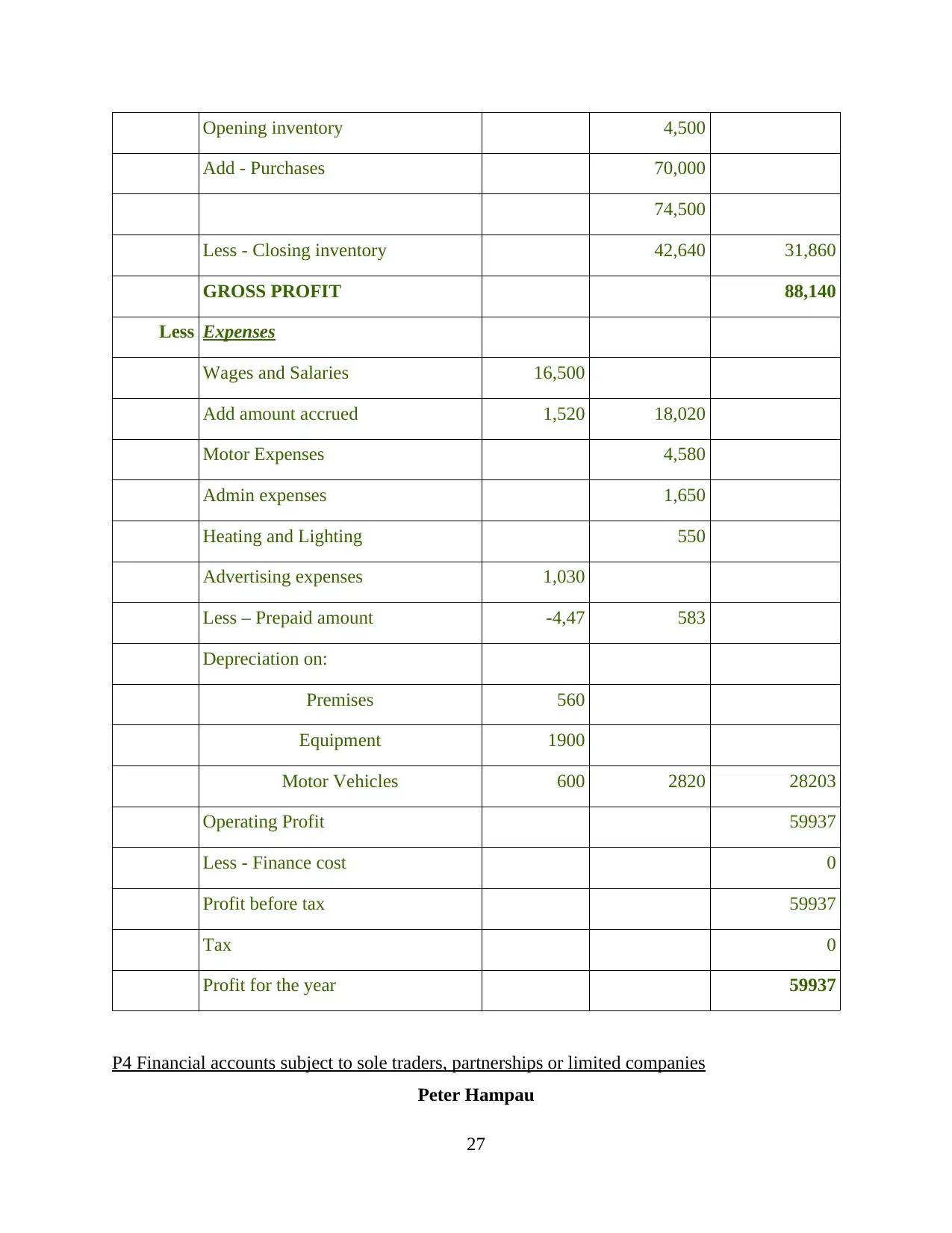
Opening inventory 4,500
Add - Purchases 70,000
74,500
Less - Closing inventory 42,640 31,860
GROSS PROFIT 88,140
Less Expenses
Wages and Salaries 16,500
Add amount accrued 1,520 18,020
Motor Expenses 4,580
Admin expenses 1,650
Heating and Lighting 550
Advertising expenses 1,030
Less – Prepaid amount -4,47 583
Depreciation on:
Premises 560
Equipment 1900
Motor Vehicles 600 2820 28203
Operating Profit 59937
Less - Finance cost 0
Profit before tax 59937
Tax 0
Profit for the year 59937
P4 Financial accounts subject to sole traders, partnerships or limited companies
Peter Hampau
27
Add - Purchases 70,000
74,500
Less - Closing inventory 42,640 31,860
GROSS PROFIT 88,140
Less Expenses
Wages and Salaries 16,500
Add amount accrued 1,520 18,020
Motor Expenses 4,580
Admin expenses 1,650
Heating and Lighting 550
Advertising expenses 1,030
Less – Prepaid amount -4,47 583
Depreciation on:
Premises 560
Equipment 1900
Motor Vehicles 600 2820 28203
Operating Profit 59937
Less - Finance cost 0
Profit before tax 59937
Tax 0
Profit for the year 59937
P4 Financial accounts subject to sole traders, partnerships or limited companies
Peter Hampau
27

Statement of Financial position as at 31st July 2018
ASSETS £ £ £
Non-current Assets Cost Accumulated
Depreciation
Carrying
Amount
Freehold Premises (4450+560) 28,000 -5080 22,990
Equipment (6800+1900) 19,000 -8700 10,300
Motor Vehicles (1200+600) 3,000 -1560 1440
50,000 -15270 34,730
Current Assets
Inventory 42,640
Trade Receivables 11,520
Prepayments: advertising 4,47
cash 300 54907
TOTAL ASSETS 89637
EQUITY AND LIABILITIES
Equity
Capital 24,380
add profit for the year 59937
less Drawings -2,800
Total Equity 81517
Current Liabilities
Trade Payables 5,600
Accruals: Wages and salaries 1,520
Bank Overdraft 1,000 8,120
TOTAL EQUITY AND LIABILITIES 89637
28
ASSETS £ £ £
Non-current Assets Cost Accumulated
Depreciation
Carrying
Amount
Freehold Premises (4450+560) 28,000 -5080 22,990
Equipment (6800+1900) 19,000 -8700 10,300
Motor Vehicles (1200+600) 3,000 -1560 1440
50,000 -15270 34,730
Current Assets
Inventory 42,640
Trade Receivables 11,520
Prepayments: advertising 4,47
cash 300 54907
TOTAL ASSETS 89637
EQUITY AND LIABILITIES
Equity
Capital 24,380
add profit for the year 59937
less Drawings -2,800
Total Equity 81517
Current Liabilities
Trade Payables 5,600
Accruals: Wages and salaries 1,520
Bank Overdraft 1,000 8,120
TOTAL EQUITY AND LIABILITIES 89637
28
Paraphrase This Document
Need a fresh take? Get an instant paraphrase of this document with our AI Paraphraser
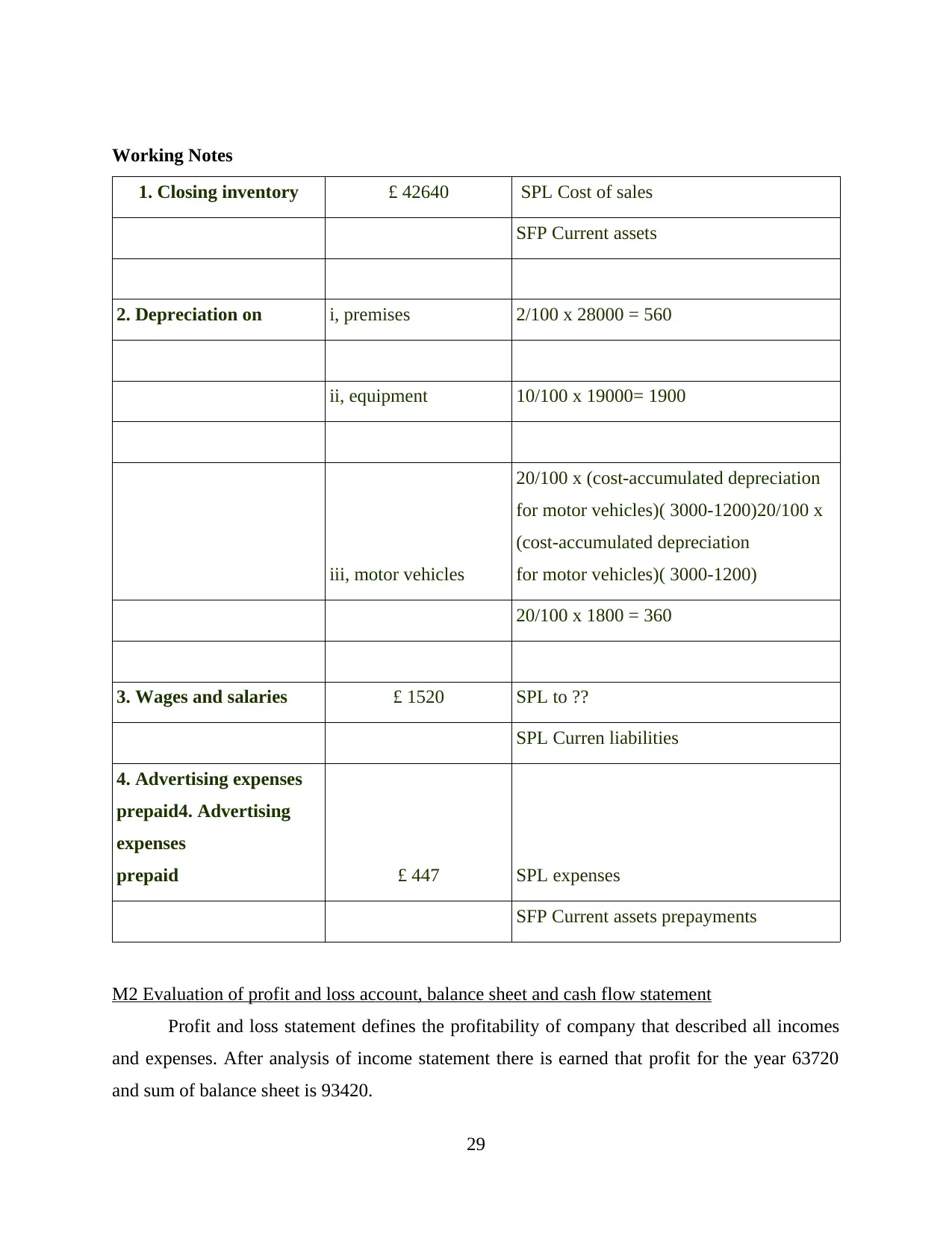
Working Notes
1. Closing inventory £ 42640 SPL Cost of sales
SFP Current assets
2. Depreciation on i, premises 2/100 x 28000 = 560
ii, equipment 10/100 x 19000= 1900
iii, motor vehicles
20/100 x (cost-accumulated depreciation
for motor vehicles)( 3000-1200)20/100 x
(cost-accumulated depreciation
for motor vehicles)( 3000-1200)
20/100 x 1800 = 360
3. Wages and salaries £ 1520 SPL to ??
SPL Curren liabilities
4. Advertising expenses
prepaid4. Advertising
expenses
prepaid £ 447 SPL expenses
SFP Current assets prepayments
M2 Evaluation of profit and loss account, balance sheet and cash flow statement
Profit and loss statement defines the profitability of company that described all incomes
and expenses. After analysis of income statement there is earned that profit for the year 63720
and sum of balance sheet is 93420.
29
1. Closing inventory £ 42640 SPL Cost of sales
SFP Current assets
2. Depreciation on i, premises 2/100 x 28000 = 560
ii, equipment 10/100 x 19000= 1900
iii, motor vehicles
20/100 x (cost-accumulated depreciation
for motor vehicles)( 3000-1200)20/100 x
(cost-accumulated depreciation
for motor vehicles)( 3000-1200)
20/100 x 1800 = 360
3. Wages and salaries £ 1520 SPL to ??
SPL Curren liabilities
4. Advertising expenses
prepaid4. Advertising
expenses
prepaid £ 447 SPL expenses
SFP Current assets prepayments
M2 Evaluation of profit and loss account, balance sheet and cash flow statement
Profit and loss statement defines the profitability of company that described all incomes
and expenses. After analysis of income statement there is earned that profit for the year 63720
and sum of balance sheet is 93420.
29
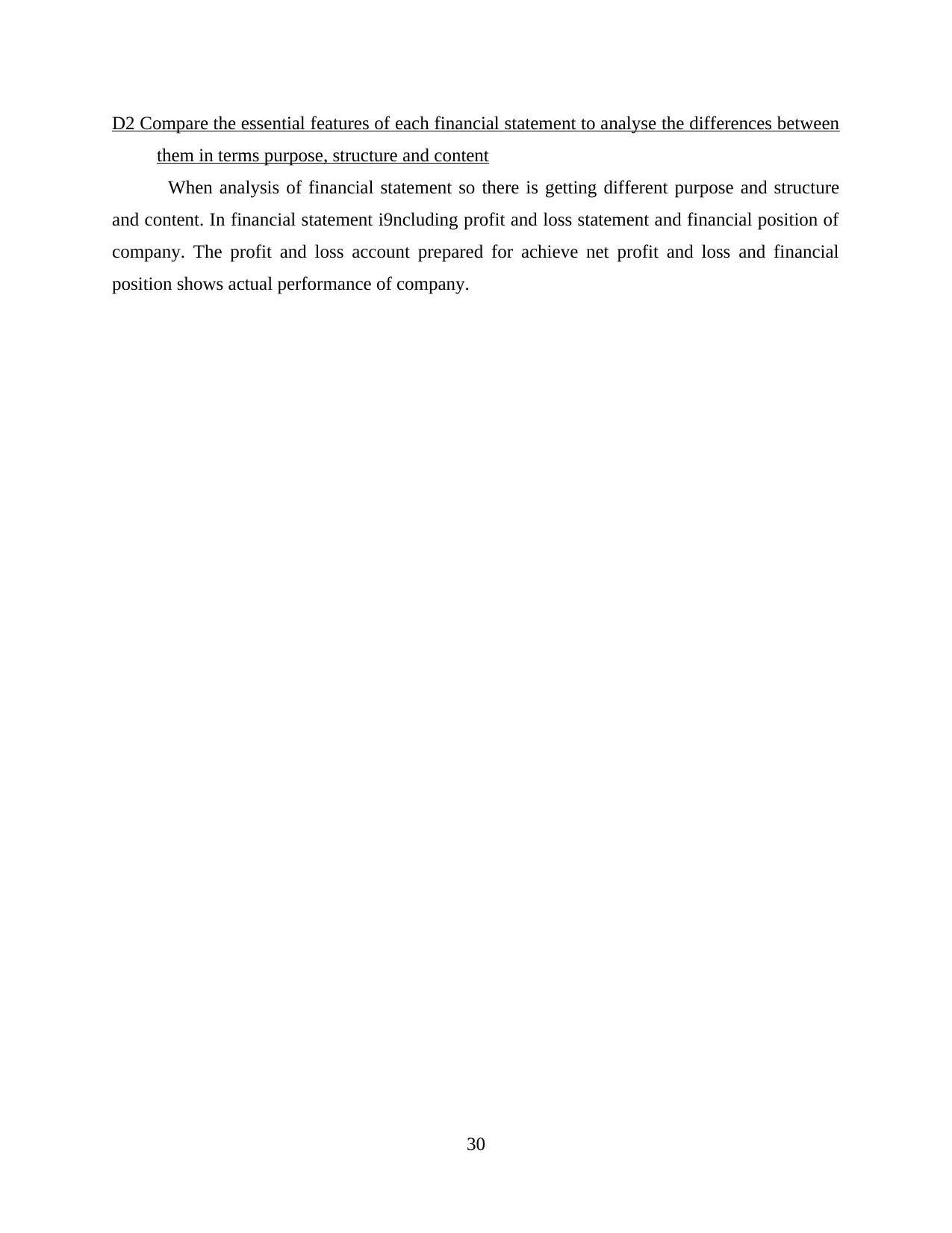
D2 Compare the essential features of each financial statement to analyse the differences between
them in terms purpose, structure and content
When analysis of financial statement so there is getting different purpose and structure
and content. In financial statement i9ncluding profit and loss statement and financial position of
company. The profit and loss account prepared for achieve net profit and loss and financial
position shows actual performance of company.
30
them in terms purpose, structure and content
When analysis of financial statement so there is getting different purpose and structure
and content. In financial statement i9ncluding profit and loss statement and financial position of
company. The profit and loss account prepared for achieve net profit and loss and financial
position shows actual performance of company.
30
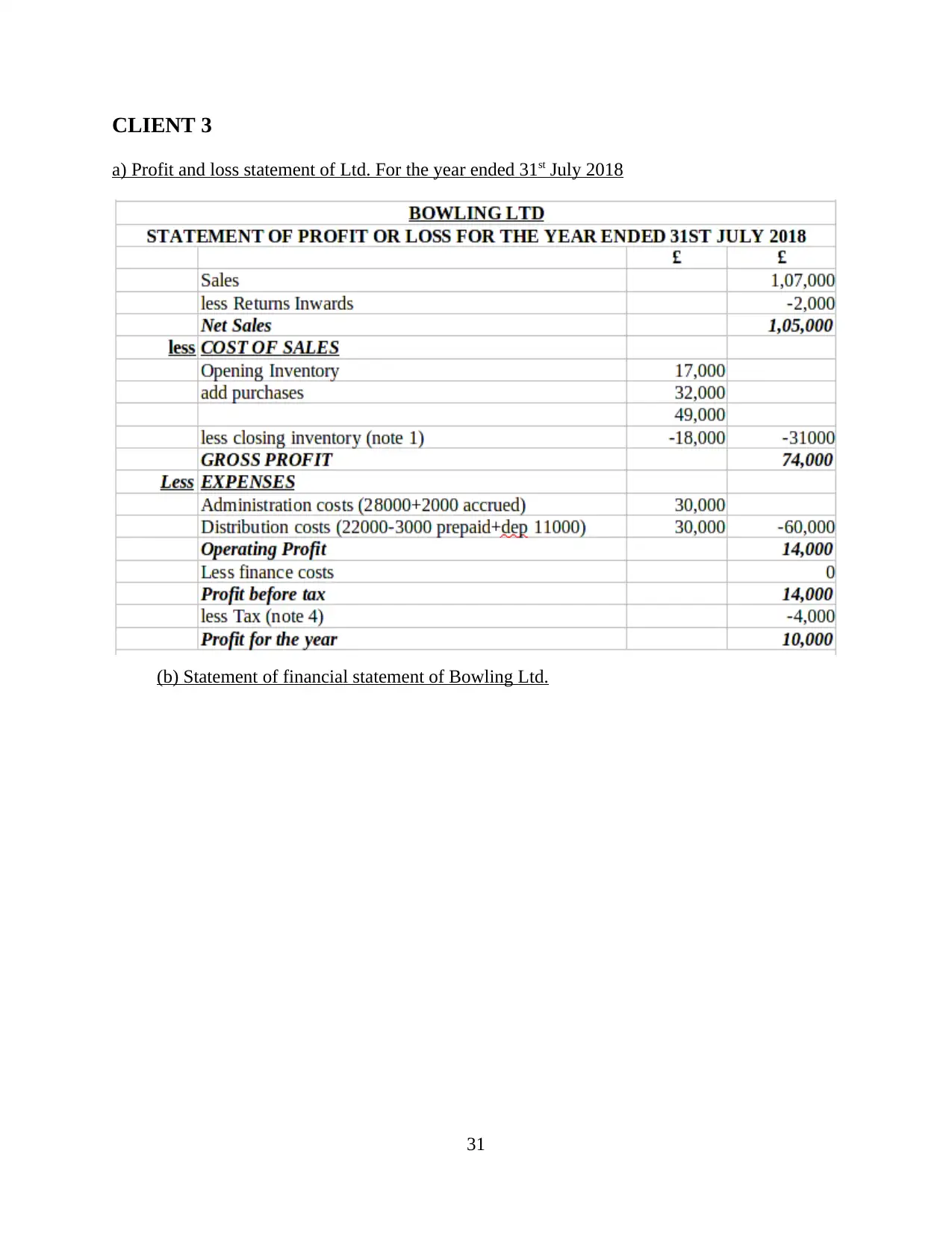
CLIENT 3
a) Profit and loss statement of Ltd. For the year ended 31st July 2018
(b) Statement of financial statement of Bowling Ltd.
31
a) Profit and loss statement of Ltd. For the year ended 31st July 2018
(b) Statement of financial statement of Bowling Ltd.
31
Secure Best Marks with AI Grader
Need help grading? Try our AI Grader for instant feedback on your assignments.
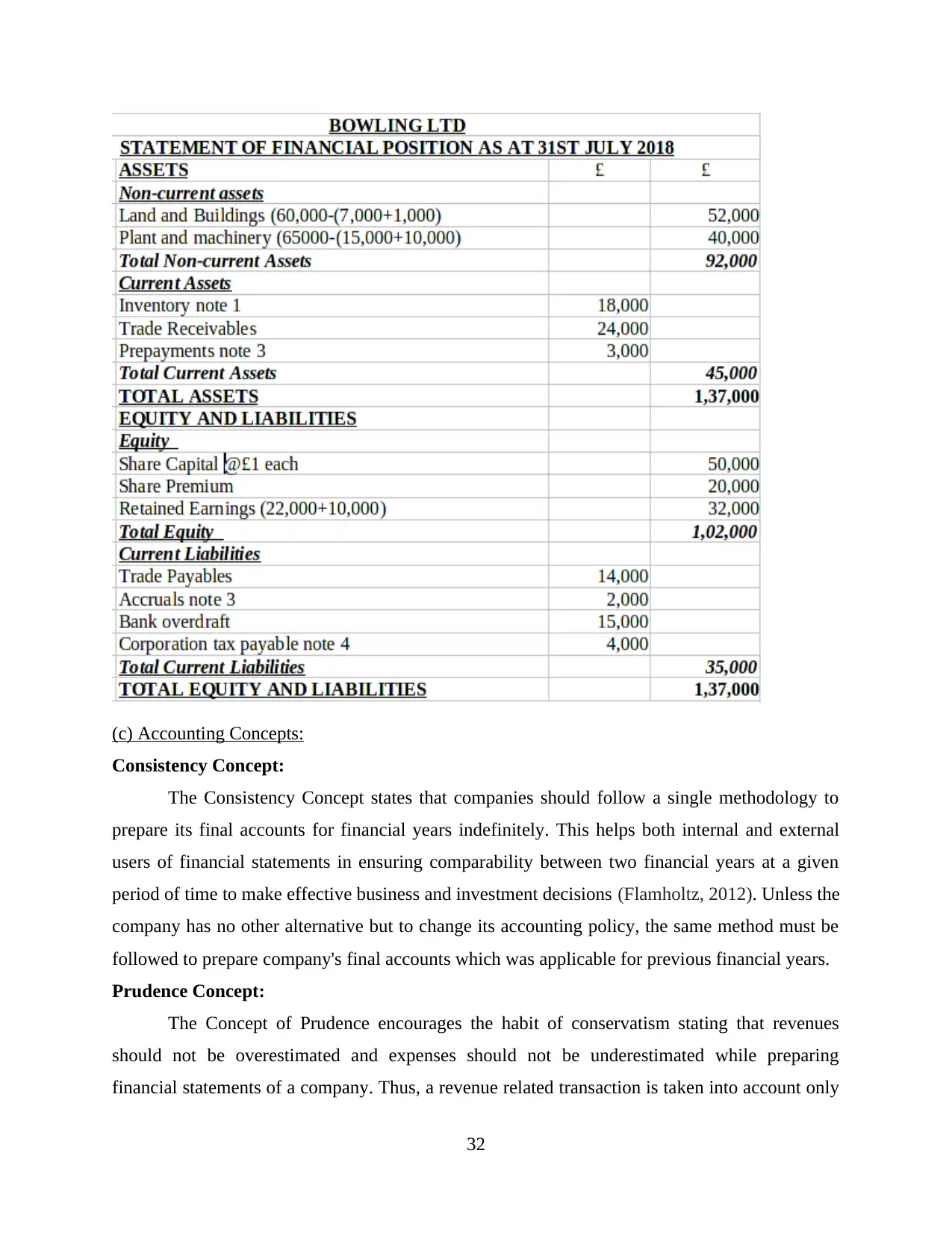
(c) Accounting Concepts:
Consistency Concept:
The Consistency Concept states that companies should follow a single methodology to
prepare its final accounts for financial years indefinitely. This helps both internal and external
users of financial statements in ensuring comparability between two financial years at a given
period of time to make effective business and investment decisions (Flamholtz, 2012). Unless the
company has no other alternative but to change its accounting policy, the same method must be
followed to prepare company's final accounts which was applicable for previous financial years.
Prudence Concept:
The Concept of Prudence encourages the habit of conservatism stating that revenues
should not be overestimated and expenses should not be underestimated while preparing
financial statements of a company. Thus, a revenue related transaction is taken into account only
32
Consistency Concept:
The Consistency Concept states that companies should follow a single methodology to
prepare its final accounts for financial years indefinitely. This helps both internal and external
users of financial statements in ensuring comparability between two financial years at a given
period of time to make effective business and investment decisions (Flamholtz, 2012). Unless the
company has no other alternative but to change its accounting policy, the same method must be
followed to prepare company's final accounts which was applicable for previous financial years.
Prudence Concept:
The Concept of Prudence encourages the habit of conservatism stating that revenues
should not be overestimated and expenses should not be underestimated while preparing
financial statements of a company. Thus, a revenue related transaction is taken into account only
32
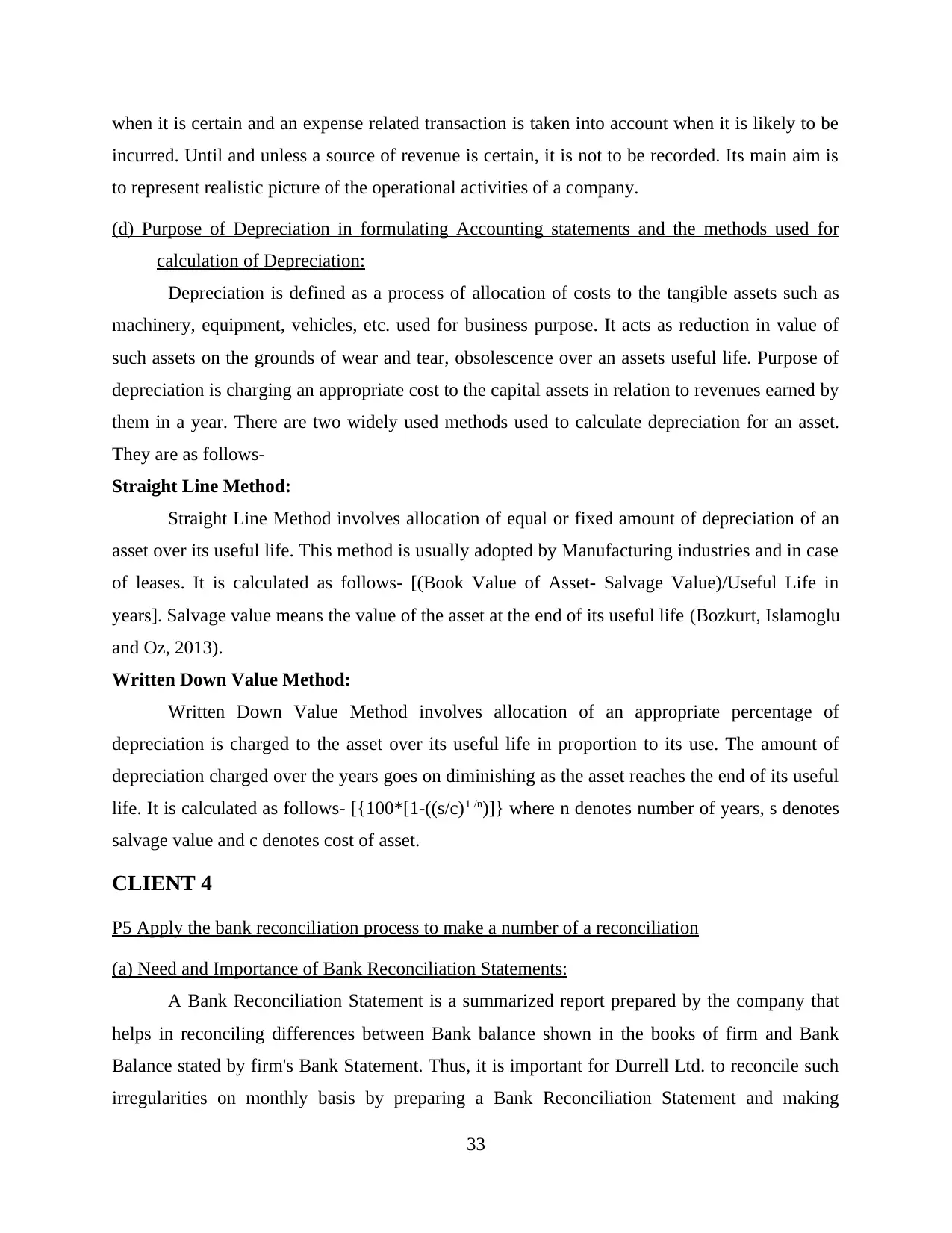
when it is certain and an expense related transaction is taken into account when it is likely to be
incurred. Until and unless a source of revenue is certain, it is not to be recorded. Its main aim is
to represent realistic picture of the operational activities of a company.
(d) Purpose of Depreciation in formulating Accounting statements and the methods used for
calculation of Depreciation:
Depreciation is defined as a process of allocation of costs to the tangible assets such as
machinery, equipment, vehicles, etc. used for business purpose. It acts as reduction in value of
such assets on the grounds of wear and tear, obsolescence over an assets useful life. Purpose of
depreciation is charging an appropriate cost to the capital assets in relation to revenues earned by
them in a year. There are two widely used methods used to calculate depreciation for an asset.
They are as follows-
Straight Line Method:
Straight Line Method involves allocation of equal or fixed amount of depreciation of an
asset over its useful life. This method is usually adopted by Manufacturing industries and in case
of leases. It is calculated as follows- [(Book Value of Asset- Salvage Value)/Useful Life in
years]. Salvage value means the value of the asset at the end of its useful life (Bozkurt, Islamoglu
and Oz, 2013).
Written Down Value Method:
Written Down Value Method involves allocation of an appropriate percentage of
depreciation is charged to the asset over its useful life in proportion to its use. The amount of
depreciation charged over the years goes on diminishing as the asset reaches the end of its useful
life. It is calculated as follows- [{100*[1-((s/c)1 /n)]} where n denotes number of years, s denotes
salvage value and c denotes cost of asset.
CLIENT 4
P5 Apply the bank reconciliation process to make a number of a reconciliation
(a) Need and Importance of Bank Reconciliation Statements:
A Bank Reconciliation Statement is a summarized report prepared by the company that
helps in reconciling differences between Bank balance shown in the books of firm and Bank
Balance stated by firm's Bank Statement. Thus, it is important for Durrell Ltd. to reconcile such
irregularities on monthly basis by preparing a Bank Reconciliation Statement and making
33
incurred. Until and unless a source of revenue is certain, it is not to be recorded. Its main aim is
to represent realistic picture of the operational activities of a company.
(d) Purpose of Depreciation in formulating Accounting statements and the methods used for
calculation of Depreciation:
Depreciation is defined as a process of allocation of costs to the tangible assets such as
machinery, equipment, vehicles, etc. used for business purpose. It acts as reduction in value of
such assets on the grounds of wear and tear, obsolescence over an assets useful life. Purpose of
depreciation is charging an appropriate cost to the capital assets in relation to revenues earned by
them in a year. There are two widely used methods used to calculate depreciation for an asset.
They are as follows-
Straight Line Method:
Straight Line Method involves allocation of equal or fixed amount of depreciation of an
asset over its useful life. This method is usually adopted by Manufacturing industries and in case
of leases. It is calculated as follows- [(Book Value of Asset- Salvage Value)/Useful Life in
years]. Salvage value means the value of the asset at the end of its useful life (Bozkurt, Islamoglu
and Oz, 2013).
Written Down Value Method:
Written Down Value Method involves allocation of an appropriate percentage of
depreciation is charged to the asset over its useful life in proportion to its use. The amount of
depreciation charged over the years goes on diminishing as the asset reaches the end of its useful
life. It is calculated as follows- [{100*[1-((s/c)1 /n)]} where n denotes number of years, s denotes
salvage value and c denotes cost of asset.
CLIENT 4
P5 Apply the bank reconciliation process to make a number of a reconciliation
(a) Need and Importance of Bank Reconciliation Statements:
A Bank Reconciliation Statement is a summarized report prepared by the company that
helps in reconciling differences between Bank balance shown in the books of firm and Bank
Balance stated by firm's Bank Statement. Thus, it is important for Durrell Ltd. to reconcile such
irregularities on monthly basis by preparing a Bank Reconciliation Statement and making
33
1 out of 36
Related Documents
Your All-in-One AI-Powered Toolkit for Academic Success.
+13062052269
info@desklib.com
Available 24*7 on WhatsApp / Email
![[object Object]](/_next/static/media/star-bottom.7253800d.svg)
Unlock your academic potential
© 2024 | Zucol Services PVT LTD | All rights reserved.





